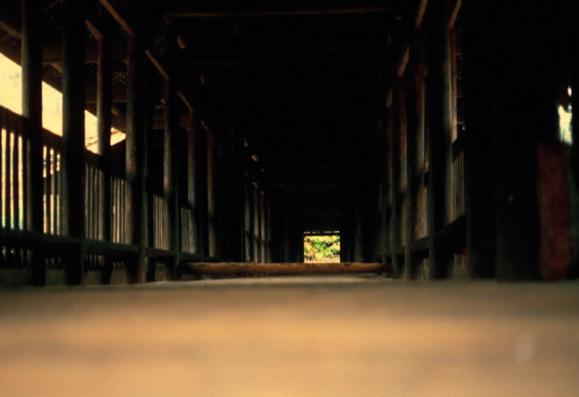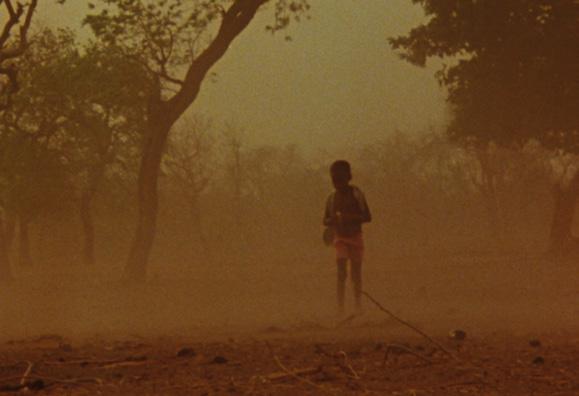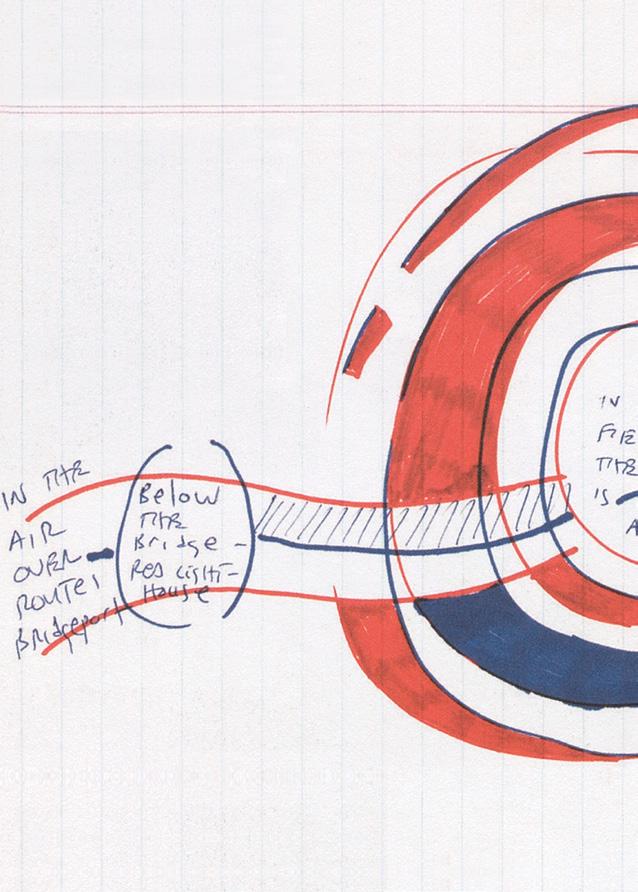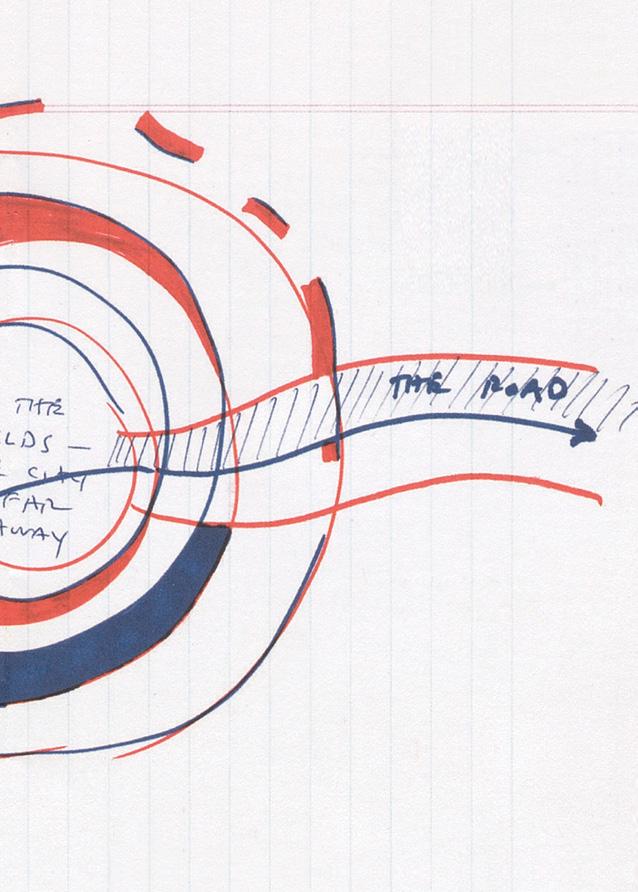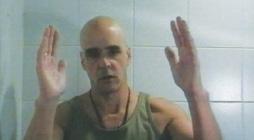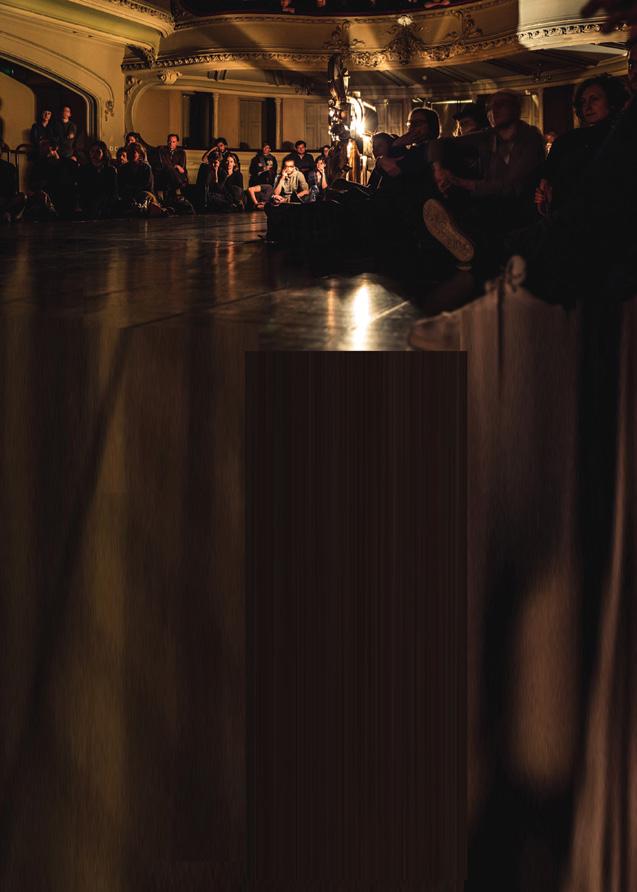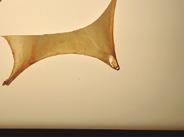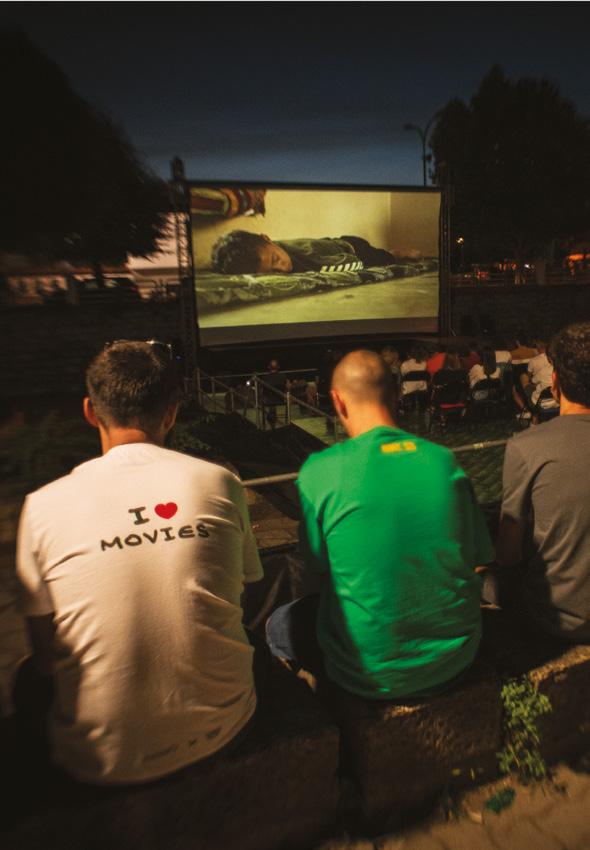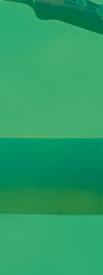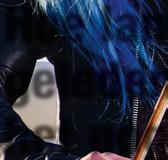


“Elke reis is het ontvouwen van een poëtica,” aldus Trinh T. Minh-ha. Het vertrek, de oversteek, het landen, het zwerven, de ontdekking, de mogelijke terugkeer en, uiteindelijk, onvermoed, de transformatie. De reis is wat ons fysiek van een plaats naar een andere brengt volgens een in kaart gebrachte beweging, maar het is ook wat ons ongeijkte paden opstuurt en onbestemde oorden laat ontdekken. Het reizen wordt gemeenzaam beschouwd als wat ons hetzelfde doet vinden door ons te verplaatsen naar het andere, maar het is ook wat ons het andere kan laten ontdekken in hetzelfde. Eensklaps wordt alles veilig en vastomlijnd aan het wankelen gebracht, de grenzen tussen hier en elders vervagen, de contouren van het zelf verliezen alle houvast.
“De ware vondst is om tussen de dingen te bewegen,” aldus Robert Kramer. Hier en daar, documentaire en fictie, binnen en buiten: van de ene categorie naar de andere, de enige manier om te overleven is om te weigeren. Weigeren om te verworden tot een integreerbaar element. Weigeren om toe te staan dat namen en identiteiten geconsolideerd worden. Weigeren om te verstenen. Blijven bewegen. Blijven verzetten tegen het naturaliseren en homogeniseren van het ‘thuis’ als een onbetwistbaar referentiepunt op wiens autoriteit men zich onwrikbaar kan verlaten. Nooit genoegen nemen met stabiliteit, van taal, van representatie, van aanwezigheid. Niets blijft onbewogen; alles wat gedefinieerd en gedetermineerd lijkt lost op in het onderweg, in het tussenin.
Het ‘onderweg/tussenin’ loopt als een rode draad doorheen dit festivalprogramma. Het staat niet enkel centraal in het werk van Trinh T. Minh-ha en Robert Kramer, die zich elk op hun eigen manier verzetten tegen elke vorm van verkokering door telkens opnieuw gevestigde begrenzingen te herschikken en verleggen, inclusief die van zichzelf. Het vormt ook het grondthema van het programma The Murmur of the World, een selectie van cartografische ficties die een onderkomen bieden aan een veelheid van gebieden, stemmen, talen en levensmogelijkheden die tegendraadse perspectieven biedt op wat ‘samenhorigheid’ kan betekenen.
‘Onderweg’ en ‘tussenin’ laten zich ook voelen in nieuw werk van onder andere Fairuz Ghammam, Lisa Spilliaert, Alia Syed, Collectif Faire-Part, Sylvain George en Rebecca Jane Arthur, die de dichotomieën tussen hier en daar, thuis en elders, binnen en buiten, in vraag stellen en daarmee bijdragen tot het inzien van de onmogelijkheid om een ‘authentieke’ culturele identiteit te definiëren. Misschien kan het geen kwaad om, nu woorden zoals ‘identiteit’ en ‘gemeenschap’ menige agenda’s kleuren, te zien hoe door en door hybride historische en culturele ervaringen zijn, of hoe radicaal ze zich ontwikkelen binnen schijnbaar conflictueuze en onverenigbare domeinen, voorbijgaand aan territoriale en disciplinaire grenzen, haaks op beleidsgerichte logica’s en nationalistische tendensen. Om in te zien dat de ‘ander’ en het ‘andere’ nooit alleen elders en buiten onszelf te vinden zijn, maar ook altijd hier, tussen ons, deel van ons.
“Every voyage is the unfolding of a poetic,” says Trinh T. Minh-ha. The departure, the crossing, the landing, the wandering, the discovery, the possible return and, finally, unsuspectedly, the transformation. The voyage is what takes us physically from one place to another according to a mapped-out movement, but it is also what sends us down uncharted paths and allows us to discover indeterminate places. Travel is commonly regarded as what makes us find the same by moving to the other, but it is also what can make us discover the other in the same. Suddenly, everything secure and fixed is shaken, the boundaries between here and elsewhere blur, the contours of the self lose all hold.
“The real find is being between things,” says Robert Kramer. Here and there, documentary and fiction, inside and outside: from one category to another, the only way to survive is to refuse. Refuse to become an integral element. Refuse to allow names and identities to be consolidated. Refuse to be petrified. Keep moving. Keep resisting the naturalisation and homogenisation of ‘home’ as an indisputable point of reference on whose authority one can unwaveringly rely. Never settle for stability, of language, of representation, of presence. Nothing remains unmoved; everything that seems defined and determined dissolves along the way, into the in-between.
The in-between runs like a thread throughout this festival programme. It is not only central to the work of Trinh T. Minh-ha and Robert Kramer, who each in their own way resist any form of compartmentalisation by repeatedly rearranging and shifting established boundaries, including their own. It’s also the fundamental theme of the programme The Murmur of the World, a selection of cartographic fictions that accommodate a multitude of territories, voices, languages and possibilities of life that offer contrarian perspectives on what ‘togetherness’ can mean.
The themes ‘on the road’ and ‘in between’ also make themselves felt in new works by the likes of Fairuz Ghammam, Lisa Spilliaert, Alia Syed, Collectif Faire-Part, Sylvain George and Rebecca Jane Arthur, who question the dichotomies between here and there, home and elsewhere, inside and outside, thereby contributing to an understanding of the impossibility of defining an ‘authentic’ cultural identity. As words like ‘identity’ and ‘community’ colour many an agenda, perhaps it does not hurt to see how thoroughly hybrid historical and cultural experiences are, or how radically they develop within seemingly conflictual and incompatible domains, beyond territorial and disciplinary boundaries, at odds with policy-oriented logics and nationalist tendencies. To recognise that ‘the other’ is never only to be found over there, elsewhere and outside of ourselves, but also always over here, between us, part of us.

Selection
Een dialoog tussen recente en herontdekte films van kunstenaars en filmmakers die zich bewegen door het uitgestrekte landschap van het bewegend beeld.
A dialogue between recent and rediscovered films by artists and filmmakers who work in the expanded landscape of moving image practices.



MINARD
WOE/WED 29 MARCH 19:30
OPENING NIGHT
The Man Who Envied Women
Yvonne Rainer
1985, US, 16mm to digital, English spoken, 125 min Digital restoration by MoMA and the Celeste Bartos Fund for Film Preservation
Yvonne Rainer construeert rond een bekend thema – het uiteenvallen van een huwelijk – een waanzinnig grappig relaas van een zelfingenomen rokkenjager. Zittend in een stoel tegenover de camera blijft Jack Deller (afwisselend gespeeld door twee acteurs) doordraven over vrouwen, wier visuele afwezigheid doorheen de hele film loopt. Op de soundtrack horen we hun vragen en opmerkingen, soms kwaad of soms eerder laconiek, die Dellers zelfverzekerde discours zowel benadrukken als ondermijnen. De gesproken woorden zijn ontleend aan teksten uit film en alledaagse cultuur, uit poststructuralistische, psychoanalytische en feministische theorieën. Behalve het thema van de mislukte (heteroseksuele) relatie, worden andere strijdarena’s verkend: de woningnood en gentrificatie in New York in de jaren tachtig, abortusrechten, de gewelddadige interventies van de VS in Latijns-Amerika. Een oneindige collage van tegenstrijdige betekenisniveaus resulteert in steeds nieuwe connecties en contexten. Barbara Kruger schreef in Artforum in 1986: “Rainer streeft niet naar een soort welgemanierde correctheid of een meesterlijke, vaderlijke notie van ‘transcendente intellectuele helderheid’; ze neigt eerder naar een soort tuimelingsproces, een verstoring van het evenwicht tussen macht, taal en lichaam.” (Berlinale Forum Expanded)
Around a familiar theme – the breakup of a marriage –Yvonne Rainer constructs a wickedly funny account of a self-satisfied womaniser. Sitting in a chair facing the camera, Jack Deller (played alternately by two actors) rambles on about women, whose visual absence runs through the entire film. On the soundtrack we hear their questions and comments, by turns enraged or laconic, both stressing and also subverting Deller’s self-assured discourse. The spoken words are taken from texts found in film and everyday culture, from poststructuralist, psychoanalytic and feminist theory. Aside from the theme of the failed (heterosexual) relationship, further fields of conflict get explored – the housing shortage and gentrification in New York during the 1980s, abortion rights, the violent interventions of the US in Latin America. A never-ending collage made up of contradictory levels of meaning results in producing ever new connections and contexts. Barbara Kruger wrote in Artforum in 1986: “Rainer is not trying for some kind of well-mannered correctness or a masterly, fatherly notion of ‘transcendent intellectual clarity’; rather, she tends toward a type of tumbling process, an unbalancing of power, language, and the body.” (Berlinale Forum Expanded)
Coming soon: all seven recently restored films by Yvonne Rainer – Lives of Performers (1972), Film About a Woman Who… (1974), Talking Pictures (1976), Journeys from Berlin/1971 (1980), The Man Who Envied Women (1985), Privilege (1990), MURDER and murder (1996) – will be presented in collaboration with CINEMATEK and Cinea.
Special thanks to Zeitgeist Films & Kino Lorber
Voor de openingsavond is een ticket in voorverkoop nodig, voor Vrienden van Courtisane, genodigden en geaccrediteerden is een reservatie nodig. (zie p. 82)
For the opening night a presale ticket is required, for Friends of Courtisane, guests and accredited a reservation is required. (see p. 82)
DON/THU 30 MARCH 13:15
Three Portrait Sketches
Margaret Tait
1951, UK, 16mm, silent, 10 min
Vroege experimenten in portretten, gemaakt in Italië.
Portretten van 1: Claudia Donzelli; 2: Saulat Rahman; 3: Fernando Birri.
Early experiments in portraiture, made in Italy.
Portraits of 1: Claudia Donzelli; 2: Saulat Rahman; 3: Fernando Birri.
Being in a Place –A Portrait of Margaret Tait
Luke Fowler
2022, UK, 35mm, English spoken, 61 min
“The contradictory or paradoxical thing is that in documentary the real things depicted are liable to lose their reality by being photographed and presented in that ‘documentary’ way, and there’s no poetry in that. In poetry, something else happens. Hard to say what it is. Presence, let’s say, soul or spirit, an empathy with whatever it is that’s dwelt upon, feeling for it – to the point of identification.” (Margaret Tait)
Luke Fowlers nieuwe film focust op Margaret Tait, een van Schotlands meest enigmatische filmmakers, puttend uit een schat aan ongezien archiefmateriaal, inclusief klankopnames, filmrushes en ongepubliceerde notitieboeken. De film vertrekt van een van Taits onverfilmde scripts voor Channel 4, met als titel Heartlandscape: Visions of Ephemerality and Permanence, en beschouwt Taits leven en werk als geworteld in het landschap van de Orkneyeilanden. Het ging Tait niet om het filmen van het landschap, maar om het kijken naar de precieze details die een plaats vormen, de kleine dingen die vaak over het hoofd worden gezien. Being in a Place verkent het proces van het maken van een film vanuit het perspectief van een collega-kunstenaar. Fowler toont affiniteit voor Taits visie van film als een poëtisch medium en brengt hulde aan de kracht van haar werkwijze, het belang van gefragmenteerde oeuvres en de intrinsieke waarde van mislukking.
voor Being in a Place – A Portrait of Margaret Tait.
Voor de gelegenheid nodigden we Patterson uit om een alternatieve live versie van dit portret ten gehore te brengen, gebaseerd op de uitgebreide klankopnames die hij maakte op de Orkneyeilanden (zie p. 80)
Lee Patterson worked on the sound recordings for Being in a Place – A Portrait of Margaret Tait For the occasion we invited Patterson to perform an alternative live version of this portrait, based on the extensive recordings he made on the Orkney islands. (see p. 80)
Drawing on a wealth of unseen archival material, including sound recordings, film rushes, offcuts and unpublished notebooks, Luke Fowler’s new feature film focuses on Margaret Tait, one of Scotland’s most enigmatic filmmakers. The film takes one of Tait’s unrealised scripts for Channel 4, entitled Heartlandscape: Visions of Ephemerality and Permanence, as its starting point and considers Tait’s life and work grounded within the landscape of Orkney. Tait was not interested in filming the scenery but instead looked at the precise details that constitute a place, the small things that are often overlooked. Exploring the process of filmmaking itself from the perspective of a fellow artist sensitive to Tait’s understanding of film as a poetic medium, Being in a Place pays tribute to the strengths in her method, the importance of fragmented bodies of work, and the intrinsic value in failure.




SPHINX CINEMA - ZAAL 3
DON/THU 30 MARCH 15:30
Mato seco em chamas — Dry Ground Burning
Joana Pimenta & Adirley Queirós
2022, BR/PT, DCP, Portuguese spoken, English subtitles, 153 min
“I was remembering the time… That I got wrapped up in some crazy shit with my sister Chitara. My sister made history in Sol Nascente. That was in 2019. I’d just got out of prison for drug charges. My sister asked me to be a part of this crazy scheme she was caught up in. She got a hold of a map of underground oil pipes. She got it and then… she bought a lot in Sol Nascente. The oil pipes ran right under her land. She started making a lot of money with that. Her, Andreia, China… They made a lot of money. So I started working with them. She took me to the lot, where she built a huge structure. Really huge, it was crazy, dope as hell. She taught me how it all worked… how to get the oil from underground, and turn it into gasoline, and all that shit… And she set up a deal with the motoboys, they would buy gasoline from her… she refined the gasoline there, and they bought it off her… Besides the motoboys, Chitara also had a spot at the P.Norte market a stand where she sold her gasoline. And a bunch of other shit. Chitara also got mixed up in politics. She made history… We had Sol Nascente on lock, we fucked things up. We really fucked things up.”
Léa tells the story of the Gasolineiras de Kebradas, as it echoes through the walls of Colmeia, the women’s prison of Brasilia, Federal District, Brazil.
Deze verbluffende mix van documentaire en speculatieve fictie is als een door de bliksem geleid bericht uit hedendaags – en misschien toekomstig – Brazilië. Dry Ground Burning vindt plaats in de bijna postapocalyptische omgeving van Sol Nascente, een favela in Brasilia. De gevreesde outlaw Chitara (Joana Darc Furtado) leidt er een volledig uit vrouwen bestaande bende die kostbare olie wegsluist en steelt van de autoritaire, gemilitariseerde regering. Haar zus Léa (Léa Alves da Silva) die onlangs werd vrijgelaten uit de gevangenis, wordt geïntroduceerd in de criminele onderneming. Queirós en Pimenta (die de DOP was van Queirós’ etnografische sciencefictionfilm
Once There Was Brasilia, vorig jaar vertoond op Courtisane festival) werken voor het eerst samen als regisseurs en combineren moeiteloos een gedramatiseerd narratief met zinderend gefilmd beeldmateriaal, waarbij de personages worden geïntegreerd in betogingen tegen Bolsonaro en fervente religieuze diensten. De vorstelijke Furtado en da Silva, die alternatieve versies van zichzelf spelen, torenen boven alles uit als de volledig bevrijde sterren van een epische, hoopvolle visie. (NYFF)
A lightning rod dispatch from contemporary – and maybe future – Brazil, this astonishing mix of documentary and speculative fiction takes place in the nearly postapocalyptic environs of the Sol Nascente favela in Brasilia. Here, fearsome outlaw Chitara (Joana Darc Furtado) leads an all-female gang that siphons and steals precious oil from the authoritarian, militarized government, while her sister, Léa (Léa Alves da Silva), recently released from prison, is brought into the criminal enterprise. Working together as directors for the first time, Queirós and Pimenta (who served as cinematographer on Queirós’s ethnographic sci-fi Once There Was Brasilia, shown last year at Courtisane festival) effortlessly combine dramatized narrative with electrifying captured footage, which integrates the characters into rallies against Bolsonaro and fervent religious services. Presiding over it all are the regal Furtado and da Silva, playing alternate-reality versions of themselves, the fully liberated stars of an epic, hopeful vision. (NYFF)
Een programma als een dubbele ‘double bill’ met werk van zus en broer Fairuz & El Moïz Ghammam, en de zussen Lisa & Clara Spilliaert. Aftastende zoektochten in de complexe ruimtes die zich bevinden tussen verschillende culturen en verschillende generaties.
A program as a double ‘double bill’ with works by sister and brother Fairuz & El Moïz Ghammam, and sisters Lisa & Clara Spilliaert. Explorations from within the complex spaces that exist between different cultures and different generations.

Fairuz Ghammam & El Moïz Ghammam
cultuur
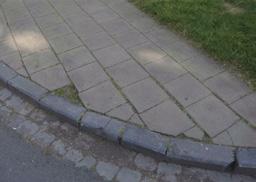
Fairuz Ghammam
2022, BE, digital, Arabic & Dutch spoken, English subtitles, 15 min cultuur is een wandeling van de private naar de publieke ruimte (en weer terug) in een continue beweging. Hoeveel herinneringen, verhaallijnen en geluiden kunnen naast elkaar bestaan?
cultuur is a walk from the private to the public space (and back again) in a continuous movement. How many memories, storylines and sounds can coexist?
Oumoun
Fairuz Ghammam & El Moïz Ghammam
2017, BE/TN, digital, Arabic spoken, English subtitles, 14 min “Beste grootmoeder, je zal verrast zijn mijn stem te horen in jouw taal...” Dit zijn de eerste woorden van een vooraf op tape ingesproken brief die nooit is verstuurd. In plaats daarvan wordt hij in real time luidop afgespeeld door de Brusselse filmmaker voor haar grootmoeder in Mahdia, Tunesië. In het gezelschap van de camera veranderen de zinnen in een voice-over die, door aandachtig te luisteren en te kijken, op zijn beurt geleidelijk transformeert in een dialoog over talen, culturen en generaties heen.
“Dear Grandma, you’ll be surprised to hear my voice in your language...” These are the first words in a recorded, spoken letter that was never sent, but was instead played aloud in real time by the Brussels filmmaker to her elderly grandmother in Mahdia, Tunisia. In the company of the camera, the lines easily turn into a voiceover that, as one listens and looks attentively, gradually transforms into a dialogue that spans languages, cultures and generations.
Hotel Red Shoes
Lisa Spilliaert & Clara Spilliaert
Lisa Spilliaert & Clara Spilliaert
2013, BE, digital, Japanese spoken, English subtitles, 15 min
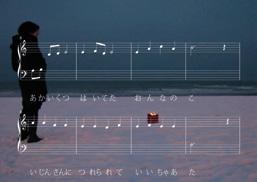
Deze video was een eerste samenwerking tussen de zussen Lisa en Clara Spilliaert en functioneert als een dubbele overgang. Enerzijds een culturele heroriëntatie van Japan naar België en anderzijds een transitie van kind naar adolescent, met referenties aan de opkomst van seksueel bewustzijn. De emotionele intensiteit van het verlaten van een bepaalde plaats of toestand wordt getranscendeerd door rituele gebaren van zingen, knippen en verbranden. In 2023 vieren we de 10de verjaardag van dit werk als een cruciaal punt op het artistieke pad van beide zussen.
This video was a first collaboration between sisters Lisa and Clara Spilliaert and functions as a double transition. On the one hand a cultural reorientation from Japan to Belgium and on the other hand a transition from child to adolescent, with reference to the emergence of sexual awareness. The emotional intensity of leaving a certain place or state is transcended by ritual gestures of singing, cutting and burning. In 2023, we celebrate the 10th anniversary of this work as a crucial point in the artistic path of both sisters.
Spilliaert
Lisa Spilliaert
2022, BE, digital, Dutch & French spoken, English subtitles, 29 min

In Spilliaert onderzoekt filmmaker Lisa Spilliaert haar bloedverwantschap met de gerenommeerde Belgische kunstenaar Léon Spilliaert (1881-1946). Is ze door deze verwantschap, die al dan niet fictief is, voorbestemd tot een kunstenaarsleven? Wordt het kunstenaarschap genetisch doorgegeven? Ze ontpopt zich als een rappende, fanatieke genealoog die de oorsprong van haar artistieke identiteit aan een onderzoek onderwerpt. Spilliaert bezoekt archieven en musea in haar hopeloze zoektocht naar documenten en aanwijzingen over haar afkomst. Uiteindelijk belandt ze middenin haar genealogische fantasieën, voorgesteld in een keramieken sculptuur van een stamboom ontworpen en gemaakt door haar zus Clara.
In Spilliaert, filmmaker Lisa Spilliaert inquires into her blood relationship with the renowned Belgian artist Léon Spilliaert (1881-1946). Is she predestined to an artist’s life by this kinship, which may or may not be fictional? Is artistry genetically transferred? She reveals herself as a rapping, fanatical genealogist who probes into the origins of her artistic identity. Spilliaert visits archives and museums, painting a picture of the hopeless search for documents and clues concerning her origins. She eventually ends up in the middle of her genealogical fantasies, represented in a ceramic sculptural family tree designed and made by her sister Clara.
In the presence of Fairuz Ghammam & El Moïz Ghammam, Clara Spilliaert & Lisa Spilliaert Presented in collaboration with Art Cinema OFFoffPADDENHOEK
DON/THU 30 MARCH 22:15
Noisy Licking, Dribbling and Spitting
Vicky Smith
2014, UK, 16mm, sound, 4 min
Smith maakte deze film, een choreografie van speeksel, door letterlijk de pellicule te likken, bekwijlen en bespugen. Het lichaamsvocht wordt geregisseerd door een met verf bevlekte tong en creëert in het proces halfautomatische, schilderachtige composities die doorsijpelen tot in het geluidsspoor, waardoor luidruchtige raspende en slippende klanken ontstaan.

A choreography of saliva, Smith made this film by literally licking, dribbling and spitting onto film, generating both image and sound. The bodily fluid directed by a stained tongue creates semi-automatic, painterly compositions and seeps into the soundtrack, generating noisy rasps and skidding sounds.

When We Were Monsters
James Richards & Steve Reinke
2020, DE/UK, digital, English spoken, 20 min Het uitgangspunt van When We Were Monsters van Steve Reinke en James Richards is een film van de kunstenaar Gretchen Bender (1951-2004), die zich baseerde op een verzameling forensische beelden van infecties, misvormingen en morbide verwondingen, die ze van een plastisch chirurg gekregen had. When We Were Monsters, gemaakt aan het begin van de COVID-19 pandemie, wordt gekenmerkt door een sfeer van moleculaire poreusheid en existentiële uitgestrektheid. Reinke en Richards breiden de medische blik van Bender uit met een bredere wetenschappelijke blik en weven een affectief tapijt van beelden – met Ivan Pavlovs spookhonden, wonden, bloemen, vlekken, vuurceremonies en hallucinaties, naast andere flitsen van eros. (Julia Stoschek Foundation)
The starting point of Steve Reinke and James Richards’ When We Were Monsters is a film made by the artist Gretchen Bender (1951–2004), who drew upon a cache of forensic images – depicting infections, deformities, and morbid injuries – given to her by a plastic surgeon. When We Were Monsters, made at the onset of the COVID-19 pandemic, is marked by an atmosphere of molecular porosity and existential vastness. Expanding Bender’s medical gaze to include a broader scientific gaze, Reinke and Richards weave an affective tapestry of images – featuring Ivan Pavlov’s ghost dogs, wounds, flowers, stains, fire ceremonies, and hallucinations, among other flashes of eros. (Julia Stoschek Foundation)
Rosebud
James Richards
2013, UK, digital, sound, 13 min
Courtesy of the artist and Rodeo, London/Piraeus
De gecensureerde beelden in Rosebud zijn opgenomen in een bibliotheek in Tokio. De boeken, monografieën over Mapplethorpe, Tillmans en Man Ray, werden vanuit Europa ingevoerd naar Japan en tegengehouden door douanebeambten. De plaatselijke wetgeving in Japan verbiedt een bibliotheek boeken te bezitten met afbeeldingen die de toeschouwer zouden kunnen opwinden. De douane stond toe dat werknemers de zending doornamen en de genitaliën van de betwiste afbeeldingen wegschuurden. De video focust op de gewelddadigheid van de handeling van het schuren en is tegelijkertijd een studie van het wrijven tegen en langs verschillende soorten oppervlakken: een meniscus van water op fotoprints, een vlierbloesem die over het lichaam van een jongen strijkt.
The censored images in Rosebud were shot in a library in Tokyo. The books, monographs on Mapplethorpe, Tillmans and Man Ray, were being imported into Japan from Europe when they were stopped by customs officials. Local law in Japan forbids a library from having books with any images that might induce arousal in a viewer. Customs did allow workers to go through the shipment and sandpaper away the genitals from any contested images. The video is focused on the violence of the action of sandpapering and at the same time a study of rubbing against and along different surfaces: the meniscus of water over the print, the elderflower rubbed along a boy’s body.
Amphetamine
Warren Sonbert & Wendy Appel
1966, US, 16mm, sound, 10 min
Amphetamine werd opgenomen toen Sonbert nog maar achttien jaar oud was, ongeveer drie jaar voor de Stonewall-rellen. De film biedt een belangrijke blik op het soort seksuele experimenten die queer jongeren naar de frontlinie van radicale, sociale transformaties zou stuwen, die toen al op til waren. De film toont Sonberts vroege narratieve stijl, die op provocerende wijze kijkt naar transgressief tienergedrag. (Tate)
Amphetamine was shot when Sonbert was only eighteen years old, approximately three years before the Stonewall riots. The film provides an important glimpse at the types of sexual experimentation that would propel queer youth to the front lines of the radical social transformations that were already underway. The film shows Sonbert’s early narrative style already defined, capturing in provocative fashion a window onto teenage transgression. (Tate)

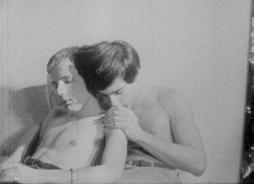 AMPHETAMINE
AMPHETAMINE
Hevn
P. Staff2021, UK, digital, sound, 5 min
Met een combinatie van digitale en analoge filmtechnieken, poëzie, handgeschilderde animaties en industrieel geluid, verkent Hevn plezier en pijn in het zieke of verzwakte lichaam alsook Staffs voortdurende interesse in de veranderlijkheid van queer- en translichamen. Beeldopnames – een douchescène, verkeer, vrienden die samenkomen – worden verduisterd en onthuld door lagen handgeschilderde film en typografie, om uiteindelijk plaats te maken voor een titelgedicht dat vraagt wat er met ons gebeurt wanneer we dromen of wanneer we wispelturig, dronken of uitgeput zijn.
Combining digital and analogue filmmaking techniques with poetry, hand painted animation and industrial sound, Hevn explores pleasure and pain in the sick or debilitated body with Staff’s ongoing interest in the volatility of queer and trans bodies. Glimpses of footage – a shower scene, traffic, friends gathering – are obscured and revealed by layers of hand painted film and lettering, eventually giving way to a titular poem that asks what happens to us in states of dreaming, volatility, inebriation and exhaustion.
Qualities of Life: Living in the Radiant Cold
James Richards
2022, DE, digital, sound, 17 min
Qualities of Life is een materiële en metaforische endoscoop die huiselijke stillevens, verval en civiele rioleringssystemen registreert en bundelt tot een poëtische en muzikale suite. Het opzet is de private en publieke dimensies van aftakeling, hygiëne en besmetting nader te bekijken. Een van de leiddraden is een reeks beelden uit het archief van Horst Ademeit, wiens obsessieve, decennialange opdracht het was de schadelijke invloed van straling op zijn lichaam en zijn omgeving te registreren. We zien ook beelden van de duizendjarige evolutie van de sociale structuur van bijen, een korte analyse van een lichaam via een MRI-scan en verschillende erotische, narcotische en nostalgische overblijfselen uit Richards appartement. De film stelt een overlevings-dilemma voor, of misschien een truc, langs de subtiel alledaagse en infrastructurele dimensie die hij doorkruist.
Qualities of Life is a material and metaphorical endoscope that records and compiles domestic still lifes, detritus, and civic sewage systems into a poetry and music suite to look closer at the private and public dimensions of decay, hygiene, and contagion. One of its guiding forces is a series of images from the archive of Horst Ademeit, whose obsessive, multi-decade imperative was to register the detrimental impact of radiations on his body and his surroundings. We also see footage from the millennial evolution of bees’ social structure, the brief analysis of a body through an MRI scan and various erotic, narcotic, and nostalgic remains from Richards’s apartment. The film poses a survivalist dilemma, or maybe a trick, in the subtly mundane and infrastructural dimension that it traverses.
STUDENT SESSIONS
KASK / School of Arts
VRI/FRI 31 MARCH students only
James Richards spreekt over zijn werk met studenten van verschillende opleidingen van KASK / School of arts
James Richards will give an artist presentation to students of several departments at KASK / School of arts
In the presence of James Richards and Vicky Smith

SPHINX CINEMA - ZAAL 3
VRI/FRI 31 MARCH 17:00
Onde Fica Esta Rua? ou Sem Antes Nem Depois

— Where Is This Street? or With No Before And After
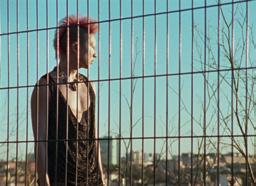
João Pedro Rodrigues & João Rui Guerra da Mata 2022, PT, DCP, Portuguese spoken, English subtitles, 88 min
“From our window one can see a set of the film The Green Years, directed by Paulo Rocha in 1963. This was our starting point: guided by Rocha's gaze, we look back at the places of that film. The successive geological, urbanistic and social strata of Lisbon, besieged by the pandemic that interrupted the shooting, are drawn out in front of our camera, like a contemporary jazz impro from a score written in 1963.”
Levenspartners en frequente co-regisseurs João Pedro Rodrigues en João Rui Guerra da Mata hebben met hun veelzijdige talenten samen een niet te classificeren verzameling resoluut hedendaagse films uitgevonden die provocerend dansen tussen fictie en non-fictie en tegelijkertijd subtiel mediteren over de filmgeschiedenis. Hun jongste samenwerking, Where Is This Street? or With No Before And After, verenigt het avant-gardistische, autobiografische en metafilmische dat hun gezamenlijk werk kenmerkt en reflecteert over een film die hun levens en het pad van de naoorlogse Portugese cinema heeft vormgegeven: The Green Years (1963) van Rodrigues’ geliefde mentor Paulo Rocha, die zijn leraar was op de filmschool. Where Is This Street? or With No Before And After bouwt verder op Rodrigues’ en da Mata’s eerste, evocatieve filmsamenwerking, de duizelingwekkende neo-noir stadssymfonie The Last Time I Saw Macao (2012), en verkent Lissabon tijdens de pandemie. Een bespookte stad, gevormd en bevolkt door diep persoonlijke maar ook gedeelde filmische herinneringen en herinneringen aan de vluchtige en liefdevol bewoonde straten die gezien zijn op het witte doek. (Harvard Film Archive)
Life partners and frequent co-directors, the polymath talents of João Pedro Rodrigues & João Rui Guerra da Mata have together invented an unclassifiable body of resolutely contemporary films that provocatively dance between fiction and nonfiction while also meditating subtly on film history. Their latest collaboration, Where Is This Street? or With No Before And After intertwines avant-garde, autobiographical and meta-cinematic threads that have defined their work together while also reflecting ruminatively upon a film that shaped their lives and the path of postwar Portuguese cinema, The Green Years (1963), by Rodrigues’ film school teacher and beloved mentor Paulo Rocha. Building on their evocative first feature collaboration, the dizzying neo-noir city symphony The Last Time I Saw Macao (2012), their latest film explores pandemic Lisbon as a haunted city shaped and inhabited by intimately personal yet shared cinematic memories, recollections of films shot on the streets, and of the streets seen and fleetingly, lovingly inhabited on the silver screen. (Harvard Film Archive)
SPHINX CINEMA - ZAAL 3
VRI/FRI 31 MARCH 22:30
Os Verdes Anos — The Green Years
Paulo Rocha
1963, PT, DCP, Portuguese spoken, English subtitles, 91 min Digital restoration by and courtesy of Cinemateca Portuguesa
Paulo Rocha’s debuutfilm The Green Years, glorieus gefilmd in zwart-wit, is een uitzonderlijk en beklijvend coming of age verhaal. De negentienjarige Julio trekt uit de provincie naar Lissabon en begint als schoenmaker te werken voor zijn oom Raul. Wanneer hij het zelfverzekerde jonge dienstmeisje Ilda ontmoet, die een vaste klant wordt in de winkel, beginnen de twee een voorzichtige romance, tot de realiteit van de buitenwereld zich opdringt.
Rocha’s film, die algemeen beschouwd wordt als de hoeksteen van de Nieuwe Portugese Cinema, reflecteerde een nieuwe houding in het kielzog van de post-Salazar modernisatie van het stadsleven in de jaren 1960. Rocha ondermijnt de melodramatische conventies, vermijdt gemakkelijke psychologie of duidelijk afgebakende doelen, verkiest mise-en-scène boven het narratieve en reflecteert zo een land dat op gespannen voet staat met zijn nationaal karakter. De moderniteit, inhoud en regie van de film opende nieuwe horizonnen voor de Portugese cinema.
Paulo Rocha’s debut feature The Green Years, gloriously shot in black and white, is an extraordinary and haunting coming-of-age tale. Nineteen-year-old Julio heads to Lisbon from the provinces and gets a job as a shoemaker for his uncle Raul. But when he meets Ilda, a confident young housemaid who becomes a regular shop visitor, the two begin a tentative romance until the realities of the outside world come crashing through.
Widely considered the founding text of the New Portuguese Cinema, Rocha’s film reflected a new attitude in the wake of post-Salazar modernization of urban life in the 1960s. Rocha subverts melodramatic conventions by avoiding easy psychology or clearly defined goals, and favors mise-en-scène over narrative, reflecting a country at odds with its national character. Through its modernity, content and direction, this film opened new horizons for Portuguese cinema.




Het werk van Maryam Tafakory hercontextualiseert op een radicale manier film, poëzie en archiefklanken en -beelden en gaat op die manier een vitale dialoog aan met de postrevolutionaire Iraanse cinema. In haar video-essays en live performances maakt Tafakory gebruik van digitale collage om nieuwe betekenislagen te creëren en bestaande te verhelderen. Tafakory’s werk richt een prismatische lens op de Iraanse cinema en manieren om verhalen te vertellen, zonder de westerse blik centraal te stellen. Haar films zijn gemaakt voor wie vertrouwd is met de culturele artefacten die ze gebruikt, maar zijn toch ook toegankelijk voor wie daar niet vertrouwd mee is. Dit programma brengt naast twee korte films van Tafakory ook een live werk dat zelden wordt uitgevoerd en dat niet mag worden opgenomen of op een andere manier gedocumenteerd mag worden. Het efemere karakter van dit werk maakt het de meest indringende expressie van Tafakory’s engagement tot wat zichtbaar is en wat niet, het taboe, het abstracte en versluierde. Het programma sluit af met een screening van The House Is Black, de enige film gemaakt door Forugh Farrokhzad, wiens geschriften en poëzie Maryam Tafakory van jongs af aan diep hebben geraakt en geïnspireerd.
Maryam Tafakory’s work radically recontextualizes film, poetry, and archival sound and image in order to create a vital dialogue with post-revolution Iranian cinema. Her video essays and live performances utilize digital collage to both create and illuminate existing layers of meaning. Tafakory’s work provides a prismatic lens onto Iranian cinema and storytelling without centering the Western gaze, accessible to those who might not be familiar with the cultural artifacts she uses, even as the films are created for those who are. This program features two of Tafakory’s resonant short films, as well as a rarely performed live piece for which there can be no recording or other form of documentation. The ephemeral quality of this work makes it the most poignant expression of Tafakory’s engagement with the seen and unseen, the taboo, the abstracted, and the veiled. The program concludes with a screening of The House Is Black, the only film made by Forugh Farrokhzad, whose writings and poetry have deeply touched and influenced Maryam Tafakory from an early age.
— Code Names
Maryam Tafakory
2022-ongoing, IR/UK, digital projection / performance / live reading, 15-20 min
Code Names herbekijkt films gemaakt in Iran na 1979 en is een archivale zoektocht naar het onuitgesprokene dat spreekt – een zoektocht naar vergeten namen, naar verboden lichamen, naar de verdwijning van vrouwen, zowel op als naast het scherm. Tafakory zal live vertellen; de uitvoeringen van dit werk zijn altijd anders en aangezien opnames niet zijn toegestaan kan dit stuk alleen deze ene keer ter plaatse en persoonlijk worden beleefd.
Revisiting films made in Iran after 1979, Code Names is an archival search for the unspoken that is speaking – a search for forgotten names, for forbidden bodies, for women’s disappearances both on and off the screen. Tafakory will be narrating live; no two performances of this work are the same, and as recording is not permitted, this piece can only be experienced this once, in person.
— Irani Bag
Maryam Tafakory
2021, IR/SG/UK, digital, Farsi spoken, English subtitles, 8 min
Irani Bag, een split-screen video-essay dat gebruikmaakt van fragmenten uit films gemaakt tussen 1990 en 2018, deconstrueert de afbeelding van een ogenschijnlijk onschuldig object – de handtas – en biedt zo een tekstuele en politieke analyse van censuur en intimiteit in postrevolutionair Iran. De toeschouwer wordt uitgenodigd om de relatie tussen zien en aanraken te herevalueren.
Using excerpts of films produced between 1990 and 2018, Irani Bag is a split-screen video essay deconstructing the depiction of a seemingly innocent object – the handbag – in order to propose a textual and political analysis of censorship and intimacy in post-revolution Iran. Irani Bag invites the spectator to reconsider the relationship between sight and touch.
— Nazarbazi
Maryam Tafakory
2022, IR/UK, digital, Farsi spoken, English subtitles, 19 min
Nazarbazi (het spel van blikken) is een film over liefde en verlangen in de Iraanse cinema, waarin afbeeldingen van intimiteit en aanrakingen tussen vrouwen en mannen zijn verboden. De film focust in de eerste plaats op beelden van vrouwen wier lichamen werden weggewist uit en geslachtofferd in de cinema van na de revolutie en alludeert op discrete vormen van communicatie die erin aan het werk zijn terwijl de censuur omzeild wordt. Nazarbazi probeert de ruimtes aan te raken die we niet kunnen aanraken; innerlijke gevoelens/gewaarwordingen – maar ook onaanraakbaarheid voorbij fysiek contact: onuitgesproken verboden/regulaties die enkel als belichaamde ervaringen ontsluierd kunnen worden. De film gebruikt poëzie en stilte als de enige talen waarmee we kunnen proberen om deze ruimtes van socio-politieke ambiguïteit aan te raken.
Nazarbazi (the play of glances) is a film about love and desire in Iranian cinema, where depictions of intimacy and touch between women and men are prohibited. The film focuses primarily on images of women whose bodies have been erased and victimised in post-revolution cinema, and alludes to discrete forms of communication that operate within, yet also circumnavigate the censors. It attempts to touch the spaces we cannot touch; inner feelings/sensations – but also untouchability beyond physical contact: unspoken prohibitions/regulators that may only unveil as embodied experiences. The film uses poetry and silence as the only language/s with which we can attempt to touch these spaces of socio-political ambiguities.
— The House Is Black
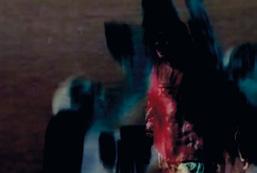
Forugh Farrokhzad
1963, IR, 35mm to digital, Farsi spoken, English subtitles, 22 min

De enige film van de baanbrekende, feministische Iraanse dichter Forugh Farrokhzad. Ze vindt onverwachte gratie waar weinigen geneigd zijn te kijken: een leprakolonie waar de bewoners leven, hun godsdienst belijden, leren, spelen en vieren in een autonome gemeenschap afgesneden van de rest van de wereld. Met een overpeinzende voice-over, geïnspireerd op het Oude Testament, de Koran en de poëzie van de filmmaker en de beelden die weigeren weg te kijken van het fysieke verschil, creëert Farrokhzad een diep empathisch portret van mensen die door de maatschappij werden afgeschreven – een onuitwisbare face-to-face ontmoeting met de menselijkheid achter de ziekte. The House Is Black, een van de belangrijkste wegbereiders voor de Iraanse New Wave, is een triomf van transcendente lyriek gemaakt door een visionaire kunstenaar van wie men de invloed nog maar pas naar waarde is beginnen schatten.
The only film directed by trailblazing feminist Iranian poet Forugh Farrokhzad. She finds unexpected grace where few would think to look: a leper colony where inhabitants live, worship, learn, play, and celebrate in a self-contained community cut off from the rest of the world. Through ruminative voiceover narration drawn from the Old Testament, the Koran, and the filmmaker’s own poetry and unflinching images that refuse to look away from physical difference, Farrokhzad creates a profoundly empathetic portrait of those cast off by society – an indelible face-toface encounter with the humanity behind the disease. A key forerunner of the Iranian New Wave, The House Is Black is a triumph of transcendent lyricism from a visionary artist whose influence is only beginning to be fully appreciated.
Followed by a conversation between Maryam Tafakory and Mahdieh Fahimi
PADDENHOEK
VRI/FRI 31 MARCH 22:30

WORM 808
Morgan Quaintance
2023, UK, drum machine audio piece


Tijdens een korte residentie in het Synthesizer archief van WORM Rotterdam maakte Quaintance opnames van een reeks improvisaties op verschillende apparaten. WORM 808 is het resultaat van een improvisatie op hun legendarische Roland 808 drum machine.
During a short residency in the Synthesiser archive at WORM Rotterdam, Quaintance recorded a series of improvisations on various pieces of equipment. WORM 808 is the result of an improvisation with their legendary Roland 808 drum machine.
A Better World
Morgan Quaintance
2023, UK, digital, sound, 3 min
Quaintance's miniatures zijn een doorlopende reeks van korte kortfilms die steeds minder dan vier minuten duren. Elke miniatuur exploreert een specifiek formeel, conceptueel of structureel idee. Het werkproces kan heel vrij en geïmproviseerd zijn, of zeer tijdsintensief en sterk gemonteerd. Alle films maken gebruik van ‘found’ footage of opnames die Quaintance draaide met een DV-, mini VHS of High 8 video camera. Het gebruik van lichte, goedkopere en makkelijk in de hand liggende media, in plaats van 16mm of een dure HD digital camera, maakt een snellere en meer intuïtieve benadering tot het produceren mogelijk. In dit programma presenteert Quaintance vijf nieuwe miniatures: A Better World, Palace, Strawberries, Numerology en Partners..
Quaintance's miniatures are an ongoing series of short shorts that are all under four minutes long. Each explores a single formal, conceptual or structural idea. The process of realisation can either be loose and improvisatory, or time intensive and heavily edited. Each of the films use footage shot with a DV camera, mini VHS or High 8 video camera, or ‘found’ footage. Using cheaper and handheld mediums, instead of 16mm (or a larger, more expensive HD digital camera), allows for a quicker, more intuitive and playful approach to production. Quaintance will present five new miniatures in this programme: A Better World, Palace, Strawberries, Numerology and Partners
Palace
Morgan Quaintance
2023, UK, digital, sound, 3 min
Repetitions

Morgan Quaintance
2022, UK, 16mm to digital, English spoken, 24 min

Repetitions, het nieuwste werk van Morgan Quaintance, is een oefening in het observeren van herhaling, het volgen van patronen en het ontcijferen van loops. Te midden van de wiegende, zich herhalende beelden en klanken focust de film zich op het teweegbrengen van retinale opwinding en toestanden van verwachting. Tegelijkertijd ontstaat er echter een duidelijker beeld van geïndustrialiseerde arbeid en de kwetsbare lichamen van zij die deze arbeid verrichten. Deze film vindt een ritme, zoals een machine, om de zorgen van de arbeidersklasse kenbaar te maken.

Morgan Quaintance's newest work, Repetitions is an exercise in observing repetition, following patterns and deciphering loops. Drawing focus through the lull of recurring images and repeating sounds, Repetitions concentrates on inducing retinal excitement and states of anticipation, but a clearer image emerges of industrialised labour and the vulnerable bodies of those performing it. This film finds a rhythm, much like a machine, to manifest the misgivings of the working class.
I Wish You Happy Moon Festival
Xiaolu Wang
2021, US/CN, digital, sound, 3 min
Sinds Xiaolu Wang meer dan tien jaar geleden naar de VS emigreerde, vervingen telefoontjes occasionele bezoekjes als de primaire communicatiemethode tussen twee generaties. Xiaolu's grootvader is al zo lang hij zich kan herinneren slechthorend, wat hun telefoontjes bijzonder moeilijk maakt. Meestal verlopen hun gesprekken net zoals op het moment dat we in de film zien. Dit is een film ter ere van Xiaolu's grootmoeder.
Since Xiaolu Wang immigrated to the U.S. more than a decade ago, phone calls replaced occasional visiting trips as the primary communication method between two generations. Xiaolu’s grandfather has been hard of hearing for as long as he remembers, which makes their phone calls especially strenuous. Most of the time, their conversations are similar to the moment we witness in the film. This is a film in honor of Xiaolu’s grandmother.
Strawberries
Morgan Quaintance
2023, UK, digital, sound, 3 min

West Lounge
Kevin Jerome Everson
2023, US, digital, English spoken, 5 min
West Lounge gaat over een ongelukkige gebeurtenis in Columbus Mississippi, verteld door een onbetrouwbare verteller.
West Lounge is about an unfortunate event in Columbus Mississippi as told by an unreliable narrator.
Numerology
Morgan Quaintance
2023, UK, digital, sound, 3 min
Partners
Morgan Quaintance 2023, UK, digital, sound, 4 min
STUDENT SESSIONS
KASK / School of Arts
DON/THU 30 MARCH students only
Morgan Quaintance spreekt over zijn werk met studenten van verschillende opleidingen van KASK / School of arts
Morgan Quaintance will give an artist presentation to students of several departments at KASK / School of arts

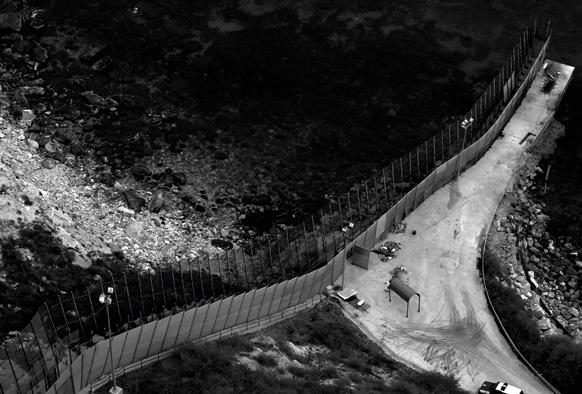

SPHINX CINEMA - ZAAL 3
ZAT/SAT 1 APRIL 14:00
Nuit obscure – Feuillets sauvages (Les brûlants, les obstinés)
— Obscure night – Wild leaves (The burning ones, the obstinate)
Sylvain George
2022, FR/CH, DCP, English subtitles, 265 min
Melilla, een Spaanse enclave in Marokko, vormt een landsgrens tussen het Afrikaanse continent en Europa. Een bufferzone waar het Europese migratiebeleid en de uitdagingen en gevolgen ervan, kunnen worden gelezen en gezien. Een plaats waar, vanuit Marokko, de ‘harragas’ samenkomen, ‘zij die verbranden’, minderjarigen en jongvolwassenen die er hun zinnen op hebben gezet om Europa te bereiken. Ze hebben niets te verliezen behalve de wil om tot het einde te leven.
De condities van migratie en strijd vormen al altijd de basis van de cinema van Sylvain George (Artist in Focus Courtisane festival 2011), een filmmaker die sinds zijn eerste werken de aandacht blijft vestigen op het medium als een krachtig politiek gereedschap. De korrel van de film wordt het materiaal waarmee de wonden die de migranten meedragen, op hun lichamen en op hun handen, worden gesculpteerd.
Tien jaar lang werkte Sylvain George aan een nieuw project in de stad Melilla, Marokko, van waaruit veel jonge mensen naar Europa vertrekken. Nuit obscure – Feuillets sauvages (Les brûlants, les obstinés) is nog maar een eerste onderdeel van een werk dat bedoeld is om onze perceptie als westerse kijkers te markeren, ons onder te dompelen in een leven veraf maar toch zo gekenmerkt door ons verlangen om blind te blijven. Melilla is hier een ontmoetingsplaats voor verschillende personages, vooral jonge mensen die klaar zijn voor hun grote reis. Ze zitten gevangen in een worsteling om te overleven, zonder economische middelen. Ze zijn continu doordrongen van het idee om te vertrekken, wat hen tot gedurfde pogingen drijft om boten binnen te dringen en drugs te gebruiken om de dagelijkse teleurstellingen te overleven. Hun lichamen, soms als ware geesten, dwalen door een stad die er vreemd uitziet, met haar lineaire geometrie, haar verleden als Spaanse kolonie en de tijd van Franco.
Melilla, a Spanish enclave in Morocco, is a land border between the African continent and Europe. A buffer zone where European migration policies, their challenges and their consequences can be read and seen. A place towards which converge, from Morocco, “those who burn”, the “harragas”, minors and young adults, eager to reach Europe. They have nothing to lose but wanting to live to the end.
The condition of migration and struggle have always been the basis of the cinema of Sylvain George (Artist in Focus Courtisane festival 2011), a filmmaker who since his first works returned to focus attention on the cinematographic medium as a powerful political tool. The grain of the film becomes the material in which to sculpt the wounds that migrants carry, both on their bodies and their hands.
For ten years, Sylvain George worked on a new project in the city of Melilla, Morocco, from which many young people leave for Europe. Nuit obscure – Feuillets sauvages (Les brûlants, les obstinés) is only the first element of a work destined to mark our perception as Western spectators, immersing us in a distant life yet one so defined by our desire to remain blind. The starting point is Melilla: a meeting place for diverse characters, mostly young people ready for their big trip, who find themselves trapped in a struggling survival, lacking economic means, continually pervaded by the idea of departure that drives them to daring attempts to board boats and use drugs to survive the disappointment each day brings. Their bodies, sometimes veritable ghosts, roam a city that seems alien, in its linear geometries and always having been a Spanish colony, from Franco’s past.
ZAT/SAT 1 APRIL 16:30
Feed/Kill
Tejal Shah
2010, IN, digital, sound, 8 min
Een scène die tegelijkertijd verleidelijk en weerzinwekkend, teder en obsceen, esthetisch opwindend en grotesk is. Omringd door bloemen, vruchten, fruitsappen en andere delicatessen zitten Tejal Shah en Marylea Madiman gehuld in Indiase klederdracht naast elkaar. Shah blijft passief zitten terwijl haar partner haar op brute wijze voedt. Het excessieve eten brengt een erotische spanning met zich mee en de interactie tussen de twee doet de grens tussen seks en agressie vervagen. Op een provocatieve manier worden menselijke condities, de relatie tussen geweld en macht, het lichaam en identiteit in vraag gesteld.
A scene that’s at once seductive and repulsive, tender and obscene, aesthetically thrilling and grotesque. Surrounded by flowers, fruits, juices and other delicacies, Tejal Shah and Marylea Madiman, dressed in Indian traditional clothing, sit side by side. Shah remains passively seated while her partner brutally feeds her. The excessive eating creates an erotic tension and the interaction between the two blurs the line between sex and aggression. In a provocative way, the human condition, the relationship between violence and power, the body and identity are questioned.

Conversation With My Mother
Jozef Robakowski
2004, PL, digital, Polish spoken, English subtitles, 7 min Een fictief telefoongesprek tussen de filmmaker en zijn moeder op haar verjaardag. Een performatieve reflectie op de relatie tussen het publieke en private waarbij de maker zijn rug naar de camera richt en de toeschouwer tegelijkertijd afschermt en meeneemt in de (on)mogelijkheid om de afstand tussen hem en zijn moeder te overbruggen. Het vastleggen van het intieme gesprek lijkt een manier te zijn om een persoonlijke herinnering bij te houden terwijl die onopgemerkt samensmelt met de herinnering van de toeschouwer.
A fictional telephone conversation between the filmmaker and his mother on her birthday. A performative reflection on the relationship between public and private spheres in which the maker turns his back to the camera, simultaneously shielding himself, and engages the viewer in the (im)possibility of bridging the gap between the man and his mother. Capturing the intimate conversation seems to be a way of keeping a personal memory alive while it merges with the viewer’s memory.


Capture 03 01 18
Josiane Pozi2019, UK, digital, English spoken, 11 min
Hoe kunnen we in ons overgetechnologiseerd tijdperk onze identiteit en onze essentiële menselijkheid vastleggen om aan elkaar duidelijk te maken wie we zijn? Met een bewegende camera die doet denken aan nostalgische home video’s beantwoordt Josiane Pozi deze vraag door zichzelf en haar familie te filmen. De dagdagelijkse realiteit in een digitale wereld wordt op abstracte en fragmentarische wijze vastgelegd. Het banale wordt verheven tot iets gewichtigs en waardevol, waarbij intieme huiskamermomenten een reactie vormen op de stereotyperende representatie van het zwarte vrouwenlichaam in traditionele beeldvorming. Pozi zet een soms ongemakkelijk en eerder onflatteus beeld neer van zichzelf en haar moeder waarbij wordt ingezoomd op de relaties binnen het gezin, de ergernissen, het plezier en de zorg voor elkaar.
In our over-technologised age, how can we capture our identity and our essential humanity to make clear to each other who we are? With a moving camera reminiscent of nostalgic home videos, Josiane Pozi answers this question by filming herself and her family. Everyday reality in a digital world is captured in an abstract and fragmentary way. The banal is elevated into something weighty and valuable, with intimate living room moments as a response to the stereotypical representations of the black female body in traditional imagery. Pozi paints a sometimes uncomfortable and rather unflattering picture of herself and her mother, zooming in on family relationships, annoyances, fun and caring for each other.
Future From Inside
Dani & Sheilah ReStack
2021, CA/US, digital, English spoken, 19 min
Future From Inside is het laatste deel van een trilogie over de wreedheid van het ouderschap, de balans tussen huishoudelijke arbeid en artistieke arbeid en queer verlangens. De films tonen de ReStack-samenwerking, zoals die zich manifesteert in het echte leven, de pijn, het ongemak, de vragen en het plezier die komen kijken bij subversief ouderschap, spiritualiteit en allerlei intieme ontmoetingen die worden betrokken in het werk. Via geënsceneerde gesprekken over een moederwens tussen dubbelgangers van het koppel maakt de film evenveel ruimte voor fictie als non-fictie, minstens zo veel plaats voor poëzie als de realiteit. Beelden van extreme intimiteit creëren momenten van inleving en nabijheid tussen de toeschouwer en het gefilmde, maar toont ook de spanning en machtsverschillen die ontstaan wanneer echte ervaringen worden vertaald in beeld.
Future From Inside is the final part of a trilogy about the brutality of parenthood, the balance between domestic and artistic labour, and queer desires. The films show the ReStack collaboration as it manifests itself in real life, the pain, discomfort, questions and pleasure involved in subversive parenting, spirituality, and all sorts of intimate encounters that are involved in the work. Through staged conversations between doubles of the couple about a mother’s wish, the film makes as much room for fiction as non-fiction, or at least as much room for poetry as reality. Images of extreme intimacy create moments of empathy and closeness between the viewer and the filmed, but they also show the tension and power differences that arise when real experiences are translated into images.
Snowflakes
André Colinet
2022, BE, 16mm to digital, silent, 2 min
Sneeuwvlokken en een klein meisje. Een intuïtief, maar bovenal liefdevol filmen plaatst een gevoel van nostalgie tegenover een idee van de toekomst. Al struinend en mijmerend wordt een cyclus van generaties tijdens een winterse wandeling in beeld gevat.

Snowflakes and a little girl. An intuitive, but above all loving way of filming the subjects juxtaposes a sense of nostalgia with an idea of the future. While wandering and musing during a winter walk, a cycle of generations is captured in images.
 In the presence of Josiane Pozi and André Colinet
FUTURE FROM INSIDE
In the presence of Josiane Pozi and André Colinet
FUTURE FROM INSIDE
PADDENHOEK
ZAT/SAT 1 APRIL 17:45
I Am Going
Jozef Robakowski1973, PL, 35mm to digital, Polish spoken, 3 min
Een duizelingwekkende beklimming op een parachutetoren in de sneeuw. In de film telt Robakowski de traptreden, steeds meer buiten adem, tot hij, na drie minuten, één filmrol lang en tweehonderd stappen boven is. De maker wordt alleen gelaten met zijn camera en via het apparaat raakt hij verbonden en verstrengeld met het landschap en zijn eigen energie. Een spel tussen de beperkingen van het psychofysische lichaam van de kunstenaar en het mechanische lichaam van zijn camera.
En Vagues
Alex Schuurbiers
2023, NL/BE, 16mm to digital, English spoken, 8 min
It comes in waves
splash, splash
En Vagues is een associatieve en vluchtige herinnering aan een mysterieus landschap en een verstoorde relatie. Het uitzicht wordt ingezet als evocatie van de ziel, ruig en verscheurd. Het verlaten eiland wordt gesmoord en gedomineerd door de zee, die haar ongevraagd, pulserend en oneindig naar zich toe trekt. De film is een sensoriële reis, een droom als de getijden verloren in de tijd. Met een soundtrack door Bert Dockx, Thomas Jillings & Louis Evrard (3/4 van de band Ottla).
En Vagues is an associative and fleeting recollection of a mysterious landscape and a disrupted relationship. The view is deployed as an evocation of the soul, rough and torn. The deserted island is smothered and dominated by the sea, which pulls it towards it uninvited, pulsating and infinite. The film is a sensory journey, a dream like the tides lost in time. With a soundtrack by Bert Dockx, Thomas Jillings & Louis Evrard (3/4 of the band Ottla).

A dizzying climb up a parachute tower in the snow. In the single-sequence film, Robakowski counts the steps, increasingly out of breath, until, after three minutes, one roll of film and two hundred steps later, he reaches the top. The maker is left alone with his camera, through which he becomes connected and entangled with the landscape and his own energy. A play between the limitations of the artist’s psychophysical body and the mechanical body of his camera.

1
Josiane Pozi2021, UK, digital, English spoken, 13 min
Een opeenvolging van banale ontmoetingen richting het zwembad van een luxueus hotel. Een ontsnapping naar een anonieme plek en exuberante levensstijl, een droom, een idee. De route is een soort sociale diegesis die zich in real time voor de auteur ontvouwt. Zonder een strikte scheiding aan te brengen tussen de realiteit en het geënsceneerde vormt Pozi een postcinematische benadering van een zelfportret waarin ze de meest alledaagse momenten in haar leven een diepere betekenis geeft. Gevoelens van eenzaamheid en uitsluiting komen aan het licht in een wereld die geobsedeerd is door het digitaal vastleggen van bijna elke seconde.
A sequence of banal encounters plays out en route to the pool of a luxury hotel. An escape to an anonymous place and exuberant lifestyle, a dream, an idea. The path is a kind of social diegesis unfolding in real time for the author. Without strictly separating reality from the staged, Pozi forms a post-cinematic approach to a self-portrait in which she gives deeper meaning to the most mundane moments of her life. Feelings of loneliness and exclusion come to light in a world obsessed with digitally capturing almost every second.
Maison Klock
André Colinet
2022, BE, 16mm to digital, silent, 3 min


Een verwelkomende filmische uitnodiging in Maison Klock van architect Willy Serneel. Op een gastvrije manier wordt de toeschouwer in een familiebubbel opgenomen, normale mensen op normale plekken in een buitengewoon zachtaardige film over kleine gebeurtenissen.


A welcoming cinematic invitation to enter architect Willy Serneel’s building Maison Klock. In a hospitable way, the viewer is drawn into a family bubble, normal people in normal places in an extraordinarily gentle film about small events.
Blind Date 2.0
Jan Soldat
2022, DE, digital, German spoken, English subtitles, 8 min De introverte Paul ontvangt op openhartige manier de filmploeg en een seksdate bij hem thuis. De film spreekt niet over lustige opwinding maar over empathie, van de filmmaker naar zijn protagonist en van de protagonist naar zijn gast. We staan met de camera in de deuropening stil. We gaan niet voor of achteruit. Vanaf de drempel weten we niet of we willen binnendringen in de extreme intimiteit of ons willen terugtrekken van de ongemakkelijke affectie.
The introverted Paul candidly welcomes the film crew and a sex date to his home. The film speaks not of lustful arousal but of empathy, of the filmmaker with his protagonist and of the protagonist with his guest. As viewers, we stand still with the camera in the doorway. We neither move forward nor backward. From the threshold, we don't know if we want to intrude into the extreme intimacy or withdraw from the uncomfortable affection.
Forest Coal Pit
Siôn Marshall Waters
2021, UK, 8mm to digital, English spoken, 15 min
Een zonovergoten zomer in Black Mountains, South Wales. Aan de zijlijn van het drukke leven, tussen de schapen, wonen twee oude broers in een hyperlokale realiteit. Ze voeren hun vee, verzorgen de tuin, en maken thee terwijl ze kletsen over olifanten in China, geesten en bestelservices. De essentie van het voorbijgaande leven, daar in de schaduw van het bestaan, lijkt te worden blootgelegd.
A sunny summer in Black Mountains, South Wales. Along the sidelines of busy life, among sheep, two elderly brothers live in a hyper local reality. They feed cattle, tend the garden, and make tea while chatting about elephants in China, ghosts, and ordering services. The essence of transient life, in the shadows of existence, seems to be laid bare.
In the presence of Alex Schuurbiers, Josiane Pozi, André Colinet, Jan Soldat, Siôn Marshall Waters
PADDENHOEK
ZAT/SAT 1 APRIL 22:30
De observerende stijl van de prominente Puerto Ricaanse filmmaker en kunstenaar Beatriz Santiago Muñoz sluit aan bij gevoeligheden van documentairefilm, maar doet ook de grenzen tussen feit en fictie vervagen. Ondanks de ogenschijnlijke eenvoud ervan, vloeit haar werk voort uit uitgebreide research, observatie en documentatie. Door het samenwerken met non-acteurs en het aanmoedigen van improvisatie, verkent Muñoz noties als authenticiteit en narrativiteit en hoe die ons begrip van geschiedenis en identiteit vormen. Binnen dit proces is de camera een instrument van bemiddeling tussen degenen voor en achter de lens. De wederzijdse erkenning van elkaars aanwezigheid is op die manier het startpunt om cruciale audiovisuele connecties tot stand te brengen, wat de conceptuele basis vormt van Santiago Muñoz' werk.
Deze selectie van oudere films en video’s van Beatriz Santiago Muñoz werd samengesteld in dialoog met Oriana, de solotentoonstelling van de kunstenaar bij argos in Brussel. Terwijl Oriana bestaat uit een multi-channel installatie die speciaal voor de argos-ruimte werd ontworpen, focust deze voorstelling op enkele single channel sleutelwerken.
Dit programma is samengesteld door Fernanda Brenner en Niels Van Tomme en wordt gepresenteerd in samenwerking met argos, Brussel.
The prominent Puerto Rican filmmaker and artist Beatriz Santiago Muñoz’s observational style aligns with sensibilities of documentary film while blurring the boundaries between fact and fiction. Santiago Muñoz’s work, despite its apparent simplicity, stems from extensive research, observation, and documentation. Collaborating with nonactors while encouraging improvisation, the artist explores notions of artifice, authenticity, and narrative, and how they shape our understanding of history and identity. Within this process, the camera is an instrument of mediation between those in front of and behind the lens. The mutual recognition of each other’s presence is thus the starting point for establishing pivotal audiovisual connections, which form the conceptual basis of Santiago Muñoz’s work.
This selection of older films and videos by Beatriz
Santiago Muñoz is organised in dialogue with Oriana, the artist’s solo exhibition at argos in Brussels. Whereas Oriana consists of a single multi-channel installation that is produced site-specifically for the argos building, this screening focuses on key single-channel works.
This program is curated by Fernanda Brenner and Niels Van Tomme, organised in collaboration with argos, Brussels.

Marché Salomon
Beatriz Santiago Muñoz
2015, PR, digital, Haitian Kréyol spoken, English subtitles, 16 min Marché Salomon portretteert twee vleesverkopers, een jonge man en vrouw, die een praatje maken op Marché Solomon, een drukke markt in Port-au-Prince. Midden in deze bedrijvige omgeving gaat het onsentimentele gesprek van de twee over de mystieke eigenschappen van alledaagse producten die verkocht worden op de markt. Ze vragen zich af of het goddelijke elk soort object kan bewonen – in bulk geproduceerde flessen, toxische rivieren, onthoofde geiten. Hun mijmeringen brengen het kosmische en het wereldlijke samen met het werk van het slachten van een geit en de figuren van de markt vormen existentiële metaforen voor het universum, tijdreizen, geesten en de dood. De jonge man observeert: “The meat sellers, they are the sun, each time they cut a piece of meat, energy flies around the universe. With all of the flies, the women, all of the vegetables, they are the planets.” Je kan de film misschien begrijpen als een reeks open vragen: welke dingen en plaatsen beschouwen we als heilig? Wie bepaalt ons begrip van het universum? Zou het mogelijk zijn om de schijnbaar onbereikbare afstand van de kosmos in de banaliteit van het alledaagse leven bloot te leggen? Zoals in haar ander werk, vermengt Beatriz Santiago Muñoz in Marché Salomon naadloos het documentaire en het filmische en drukt zo de diepe spanning uit die bestaat tussen de gemythologiseerde geschiedenis van een gekoloniseerd land en het ogenschijnlijk onschadelijke verstrijken van de tijd in het heden, wat leidt tot een beklijvende ongemakkelijkheid.
Marché Salomon depicts two meat vendors, a young man and woman, chatting in Marché Salomon, a busy Portau-Prince market. Amongst the surrounding bustle, the two have an unsentimental discussion about the mystical qualities of common products sold at the market, wondering whether the divine can inhabit any kind of object – mass produced bottles, toxic rivers, beheaded goats. Their musings weave together the cosmic and the mundane, with the work of butchering a goat and the characters of the market serving as existential metaphors for the universe, time travel, ghosts, and death. The young man observes, “The meat sellers, they are the sun, each time they cut a piece of meat, energy flies around the universe. With all of the flies, the women, all of the vegetables, they are the planets.” One might understand the film as a series of open-ended questions: What things and places do we consider sacred? Who dictates our understanding of the universe? Might we be able to uncover the seemingly unreachable distance of the cosmos in the banality of everyday life? As in her other works, Marché Salomon seamlessly blends documentary and cinematic styles to convey the deep tension that exists between the mythologized history of a colonised land and the seemingly innocuous passing of time in the present, ultimately conveying a haunting unease.
La cabeza mató a todos — The Head that Killed Everyone
Beatriz Santiago Muñoz2014, PR, digital, Spanish spoken, English subtitles, 7 min The Head that Killed Everyone is een mix van inheemse mythologieën en hedendaagse karakters, geografieën en cultuur in Puerto Rico. De titel verwijst naar hoe een vallende ster (in de lokale mythologie) werd geïnterpreteerd als een hoofd zonder lichaam dat door de lucht passeerde en de komst van chaos en vernietiging aankondigde. Katten komen veel voor op het eiland Puerto Rico en in deze video wordt de kat een mythologische entiteit die in staat is tot transformaties die de wereld veranderen. De soundtrack vervlecht tijd en ruimte en wisselt af tussen een nummer van de Peruviaanse punkband Los Psychos en de tsjilpende en kwakende muziek van de coquí-kikker die de natte landschappen van Puerto Rico bevolkt. Het samenspel van deze elementen verbeeldt een betovering die militaire industrieën kan vernietigen en de complexiteiten van dit systeem confronteert op een poëtisch eerder dan een rationeel vlak.
The Head that Killed Everyone is a mixing of indigenous mythologies with present-day characters, geographies, and culture in Puerto Rico. The title refers to how a shooting star was (in local mythology) interpreted as a head without a body, crossing the sky, signalling the arrival of chaos and destruction. Cats are very common on the island of Puerto Rico, and in this video, the cat is cast as a mythological entity, capable of world-altering transformations. The soundtrack further blends time and space as it alternates between a track from the Peruvian punk band, Los Psychos, and the chirping and croaking music of the coquí frog that populate Puerto Rico’s wet landscapes. These elements combine to imagine a spell that can destroy military industries, confronting the complexities of this system on a poetic plane rather than a rational one.

Gosila
Beatriz Santiago Muñoz2018, PR, 16mm & HD video transferred to digital, Spanish spoken, English subtitles, 10 min
Op 20 september 2017 raasde een van de meest hevige stormen die ooit het Caribisch gebied troffen over het eiland Puerto Rico. De storm, heftiger dan enige andere storm die de Puerto Ricanen ooit hadden meegemaakt, nam in kracht toe voor hij de Dominicaanse Republiek en de Amerikaanse Maagdeneilanden toetakelde en in Puerto Rico eindigde. Wie de hel van de storm overleefde kwam in de hel van de nasleep ervan terecht. Gosila documenteert in de observerende stijl van Santiago Muñoz het overhoopgehaalde en verwoeste landschap na de orkaan, het langzame en eindeloze werk van het puinruimen, de overstroomde wegen, de ongebreidelde natuur. De titel verwijst naar de cultfilm Godzilla (1954), waarin een zeeschepsel dat in een aards monster verandert het eiland Odo en daarna Tokio verwoest. Gosila is een film over wanorde, zingeving vanaf de basis, traagheid en de dagen van werk na de orkaan.

On 20 September 2017, one of the most violent storms ever to hit the Caribbean made landfall on the island of Puerto Rico. The storm, the likes of which Puerto Ricans had never experienced, gathered in intensity before tearing through the Dominican Republic and the U.S. Virgin Islands, ending in Puerto Rico. Those who survived the storm-hell were bound to the hell of its aftermath. In Santiago Muñoz’s observational style, Gosila documents the upended and devastated landscape after the hurricane, and the slow and endless work of clearing debris, water-filled roads, and unbridled nature. The title refers to the cult film Godzilla (1954), where a sea creature turned terrestrial monster destroys the island of Odo and then Tokyo. Gosila is a film about disorder, sense-making from the ground up, slowness, and the work-days after the hurricane.
Otros Usos — Other Uses
Beatriz Santiago Muñoz
2014, PR, 16mm to digital, 7 min
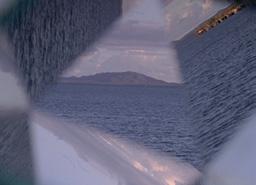
In Otros Usos traint Santiago Muñoz haar lens op het terrein van Roosevelt Roads, een voormalige marinebasis van de Verenigde Staten in Ceiba, Puerto Rico, die tot de uiteindelijke ontmanteling ervan in 2004 regelmatig het doelwit was van lokale protesten tegen de militaire aanwezigheid van de V.S. De dokken van de site, die nog steeds zijn uitgerust met militair materiaal en militaire infrastructuur, geven uit op de oceaan en worden nu gebruikt door lokale vissers. Met wisselende intervallen worden de beelden van de omgeving onvast en zien we ze spiegelen of omgekeerd vermenigvuldigen binnen het frame. Santiago Muñoz filmde doorheen reflecterende glassculpturen die ze zelf maakte, wat zorgt voor afwisselende caleidoscoopachtige beelden van de zee, de zon, het land, de lucht en figuren. Met haar camera als gereedschap vervormt en vergroot de kunstenaar onze ervaring van plaats, waardoor de grens tussen historisch feit en fictie vervaagt.
In Otros Usos, Santiago Muñoz trains her lens on the grounds of Roosevelt Roads, a former U.S. Naval base in Ceiba, Puerto Rico that was a frequent target of local protests against military presence until its ultimate decommission in 2004. The site’s docks, still fitted with abandoned military equipment and infrastructure, jut out into the ocean and are now utilised by local fishermen. At varying intervals, the scenic images become unfixed, mirroring or multiplying inversely within the frame. Santiago Muñoz shot the film through reflective glass sculptures of her own making, creating alternating, kaleidoscope-like views of sea, sun, land, sky, and figure. Using her camera as a tool, the artist both distorts and augments our experience of place, thus blurring the borders between historical fact and fiction.
La Cueva Negra
Beatriz
Santiago Muñoz2012, PR, digital, Spanish spoken, English subtitles, 20 min
La Cueva Negra verkent het Paso del Indio, een inheemse begraafplaats in Puerto Rico die ontdekt werd tijdens de werkzaamheden om een snelweg aan te leggen en die uiteindelijk onder het wegdek verdween. Santiago Muñoz’ video maakt gebruik van interviews met lokale bewoners en met archeologen die betrokken waren bij de opgraving en biedt zo een reflectie over de oorsprong en de betekenissen van de site, die op die manier een allegorie wordt voor de ingewikkelde geschiedenis van het eiland. Het project vertrekt vanuit de materiële geschiedenis van de site, de herinneringen van de arbeiders en de archeologen die bij de opgraving betrokken waren, wat we weten en wat we denken te weten over een landschap, en hoe deze lagen van materiaal en geloof met elkaar interageren en een nieuwe, hedendaagse kosmogonie creëren, opgebouwd uit het afval, de graffiti, de snelweg, de rivier, het dorp, de karstbodem en de sporen van het wereldbeeld van vroegere bewoners. De camera volgt twee tienerjongens die door het gebied struinen. Hun bewegingsvrijheid en nieuwsgierigheid symboliseren het romantische maar uiteindelijk misleidende verlangen om het paradijs te vinden en te vrijwaren.
La Cueva Negra explores the Paso del Indio, an indigenous burial ground in Puerto Rico that was discovered during the construction of a highway, and eventually paved over. Drawing on interviews with local residents and with archaeologists involved in the excavation, Santiago Muñoz’s video offers a reflection on the origins and meanings of the site, which becomes in the process an allegory for the island’s convoluted history. The project starts from the site’s material history, the recollections of the workers and archaeologists involved, what we know, and what we think we know about a landscape and how these layers of material and belief interact to create a new contemporary cosmogony, one built on the trash, the graffiti, the expressway, the river, the village, the karst bedrock and the traces of previous inhabitants’ worldview. The camera tracks two teenage boys wandering through the area, their freedom of movement and sense of curiosity symbolising the romantic but ultimately misguided desire to find and preserve paradise.

SPHINX CINEMA - ZAAL 3
ZAT/SAT 1 APRIL 22:30
+6 Gain
Jorn Plucieniczak
2019, BE, DCP, Dutch spoken, English subtitles, 26 min Symen en Sam proberen de tijd te verdrijven in de monotonie van een postindustriële voorstad. Ze lijken zich te bewegen doorheen een eeuwige schemerzone, omringd door een onzichtbare aanwezigheid van ‘Hardcore’. Ze gamen en hangen wat rond, om uiteindelijk over te gaan tot een zoektocht naar de kern van hun verlangens.
Symen and Sam try to pass their time in the monotony of a post-industrial suburb. They seem to linger in a kind of perpetual twilight that is answered by the invisible presence of ‘Hardcore’. While gaming and burning daylight, they end up searching for the core of their desires.

Black and White Trypps Number Three
Ben Russell
2007, US, 35mm, sound, 12 min
Het derde deel van een serie films over natuurlijke psychedelica. Deze film, opgenomen tijdens een optreden van Lightning Bolt, de noise-band uit Rhode Island, documenteert de transformatie van een collectieve freak-out van een rockpubliek tot een trance-ritueel van de hoogste spirituele orde.
The third part in a series of films dealing with naturallyderived psychedelia. Shot during a performance by Rhode Island noise band Lightning Bolt, this film documents the transformation of a rock audience’s collective freak-out into a trance ritual of the highest spiritual order.

Terril
Jorn Plucieniczak
2022, BE, DCP, Dutch spoken, English subtitles, 28 min
Mike keert na een lange afwezigheid terug naar huis. Hij probeert zich te verankeren in de sociale dynamiek van familie en vrienden. Het mijnlandschap van Genk biedt bijzondere openingen. De film speelt zich af in deze gedeïndustrialiseerde stad en toont de mannelijke dynamiek in een arbeidersgezin. Terril beweegt zich tussen sociale codes en legt verborgen kwetsbaarheden bloot.
Mike returns home after time away. He tries to find his place within the social structures of his family and friends. The mining landscape of Genk provides unusual openings. Set in the deindustrialised city, the film depicts the masculine dynamics within a working-class family. Terril patiently moves between these social codes and the landscape in which they manifest themselves.

Ten Men
Mark Raidpere
2003, EE, digital, sound, 8 min Courtesy of the artist and Michel Rein, Paris/Brussels
Mannelijke vervreemding en isolement zijn terugkerende thema’s in Mark Raidpere’s werk. Ten Men toont een tiental gevangenen die hun spieren opspannen en met hun tatoeages pronken voor de camera. Maar ze lijken ook beschaamd te glimlachen en kijken weg in de hoop op solidariteit.
Male alienation and isolation are recurrent themes in Mark Raidpere’s work. Ten Men shows a series of prisoners flexing their muscles and flaunting their tattoos for the camera, but also smiling in embarrassment and looking away in hope of solidarity.
 In the presence of Jorn Plucieniczak
In the presence of Jorn Plucieniczak


PADDENHOEK
ZON/SUN 2 APRIL 13:45
Hit Him on the Head with a Hard Heavy Hammer
Rebecca Jane Arthur2023, BE/UK, 16mm to digital, English spoken, 49 min
Hit Him on the Head with a Hard Heavy Hammer vertrekt van de handgeschreven memoires van de vader van de filmmaker en zijn ervaring van ontheemding tijdens oorlogstijd. Verwijzend naar het begrip dat Thomas Hardy
‘The Self-Unseeing’ (het ongeziene zelf) noemde in zijn gelijknamige gedicht uit 1901, keert de film terug naar de kindertijd en de zaken die ons harden: opvoeding, sociale status, onderwijs, arbeid en familiebanden. De memoires worden in de film verweven als een beschouwing over sterfelijkheid en een illustratie van het vervagende geheugen, nadenkend over hoe we ons verleden vastleggen en hoe het opnieuw kan worden verteld.
Hit Him on the Head with a Hard Heavy Hammer departs from the handwritten memoir of the filmmaker’s father and his experience of displacement during wartime. Referring to the notion Thomas Hardy termed ‘The Self-Unseeing’ in his eponymous 1901 poem, the film returns to childhood and the matters that harden us: upbringing, social status, education, labour, and familial bonds. The memoir weaves into the film as both a contemplation on mortality and an illustration of fading memory, reflecting on how we pen our pasts and how they can be re-told.
The Demands of Ordinary Devotion
Eva Giolo
2022, IT/BE, 16mm to digital, sound, 12 min
Een film opgebouwd op basis van een kansspel en een reeks ontmoetingen in werkplaatsen en woningen in de stad Rome. Hoewel de protagonisten nooit samen verschijnen, zijn ze onlosmakelijk verbonden door hun acties – betekenis wordt overgebracht door beweging en het bijbehorende geluid, en langzaam ontvouwt zich een visuele exploratie van lichamelijkheid. The Demands of Ordinary Devotion nodigt uit tot reflectie over het maakproces, het vooruitzicht op het moederschap en onzekerheden in creatie, balans en compositie.
A film constructed based on a game of chance and a collection of encounters in workshops and homes in the city of Rome. Although the protagonists never appear together, they are inextricably bound by their actions –meaning is conveyed through movement and its associated sound, slowly forming a visual exploration of physicality. The Demands of Ordinary Devotion invites a reflection on the process of making, the prospect of motherhood, and uncertainties in creation, balance and composition.
SPHINX CINEMA - ZAAL 3
ZON/SUN 2 APRIL 15:30
Speech for a Melting Statue
Collectif Faire-Part (Anne Reijniers, Paul Shemisi, Rob Jacobs, Nizar Saleh)

2023, BE/CG, digital, French spoken, English subtitles, 10 min
In juni 2020 kwamen in Brussel duizenden mensen op straat om een vuist te maken tegen politiegeweld en institutioneel racisme, solidair met Black Lives Matter. Op een bepaald moment leek het erop dat een aantal demonstranten het standbeeld van de koloniale koning Leopold II op een nabijgelegen plein zouden neerhalen. Op dit moment staat het standbeeld er nog, maar dichteres Marie Paule Mugeni is haar speech al aan het voorbereiden voor de dag dat het wordt verwijderd.
In June 2020, thousands of people took to the streets in Brussels to make a fist against police brutality and institutional racism in solidarity with Black Lives Matter. For a moment, it seemed that some demonstrators would take down the statue of colonial king Leopold II in a nearby square. For now the sculpture is still standing, but poet Marie Paule Mugeni already prepares her speech for the day it will be removed.
Lumumba: La mort du prophète

— Lumumba, Death of a Prophet
Raoul Peck
1991, CD/FR/CH/DE, DCP, French spoken, English subtitles, 69 min
In 1962 vervoegde Raoul Peck als kind zijn ouders die werkten in Congo, voorheen Belgisch, en pas onafhankelijk. Twee jaar eerder werd Patrice Lumumba, een mythische figuur van de Congolese onafhankelijkheid, vermoord in Katanga. Vertrekkend vanuit een door zijn moeder gevonden foto waarop de Congolese leider te zien is, maakt het kind van toen dat nu filmmaker is geworden, een zeer persoonlijke en gevoelige film waarin biografie en geschiedenis, getuigenissen en archieven het raamwerk vormen voor een reflectie over de figuur Lumumba, zijn politieke moord, de media en het geheugen.
In 1962, Haitian child Raoul Peck joined his parents, working in Congo, formerly Belgian, newly independent. Two years earlier, Patrice Lumumba, a mythical figure of Congolese independence, was killed in Katanga. From a photograph found by his mother where the Congolese leader appears, the child, turned filmmaker, realizes thirty years later, a very personal and sensitive film where biography and history, testimonies and archives constitute the frame of a reflection around the figure of Lumumba, his political assassination, the media and the memory.
“Before the age of the Internet, before digital archives could be accessed, a young Congolese who wanted to speak about his own history – when he finally could access his own archive – had to pay $3,000 for a minute of archival footage in broadcasting rights. [… ] Before we left for Congo we found out that the Mobutu regime’s services were expecting us. It was too dangerous, we had to cancel the trip and lost a number of producers. As a result we took a creative decision that gave the film its strength: we decided to shoot Lumumba in Brussels, the very city where the plan to murder him was hatched. We turned a setback into a dramatic twist and in fact integrated it into the film and that in turn gave a reflexive quality to the importance of the image (both mental and as material) in the documentary.” (Raoul Peck)
L’escale
Collectif Faire-Part (Anne Reijniers, Paul Shemisi, Rob Jacobs, Nizar Saleh)
2022, BE/CG, digital, French spoken, English subtitles, 14 min Filmmakers Paul Shemisi en Nizar Saleh reizen van de Democratische Republiek Congo naar Duitsland om hun nieuwe film voor te stellen. Tijdens een overstap in Angola worden ze op de luchthaven tegengehouden omdat de luchtvaartmaatschappij de authenticiteit van hun documenten in twijfel trekt. Paul en Nizar denken dat ze naar een hotel gebracht worden om te wachten op hun vlucht terug naar huis, maar worden eigenlijk naar een detentiecentrum voor illegalen gebracht.
De getuigenis van de filmmakers – die de onmogelijkheid van het vrij en zorgeloos reizen voor Congolese kunstenaars openbaart – staat in schril contrast met de ogenschijnlijk vredevolle beelden van wolkenformaties die passeren voorbij een vliegtuigvenster.
Filmmakers Paul Shemisi and Nizar Saleh travel from the Democratic Republic of Congo to Germany for the screening of their new film. During a layover in Angola, they’re stopped at the airport because the airline doesn’t trust their documents to be real. While Paul and Nizar think they are being led to a hotel, where they would stay until their flight back home, they are actually being taken to an illegal detention center.
The filmmakers’ testimony – which offers an eye-opening insight into the impossibility of safe and carefree travel for Congolese artists – stands in stark contrast with the seemingly peaceful images of cloud formations passing by an airplane window.
In the presence of Anne Reijniers, Nizar Saleh, Paul Shemisi and Rob Jacobs

PADDENHOEK
ZON/SUN 2 APRIL 16:00
É noite na América — It Is Night in America
Ana Vaz
2022, IT/BR/FR, 16mm to digital, Portuguese spoken, English subtitles, 66 min É noite na América is gefilmd in de zoo van Brasília die honderden dierensoorten herbergt die gered werden in de stad (reuzenmiereneters, manenwolven, uilen, savannevossen, capibara’s, caracara’s). De film is een omgekeerde etnografie die het niet-menselijke perspectief van dieren – de oorspronkelijke bewoners van een stad die gedroomd werd voor de toekomst, maar gebouwd op een erfenis van geweld en ontheemding – op de voorgrond plaatst. Zoals een lokale krant kopt: “Vallen dieren onze steden binnen of zijn wij hun habitat aan het innemen?” Vaz wijdt zich opnieuw aan haar geboorteplaats Brasília, de stad die ze reeds verkende in vroegere films als Sacris Pulso en A Idade da Pedra (getoond op het Courtisane festival in 2022), en zet haar project verder waarbij ze de traditionele machtsrelaties tussen filmmaker, camera en gefilmd onderwerp en tussen klank en beeld, ondermijnt. De dieren, een essentiële aanwezigheid in veel van Vaz’ films, zijn niet alleen het onderwerp van onze blik; zij kijken ook naar ons. Blauw is de dominante kleur; de onderbelichting het resultaat van het werken met oude en verlopen 16mm-pellicule en ook een allusie op ‘dag voor nacht’, een techniek die in het Frans ‘nuit américaine’ (‘Amerikaanse nacht’) wordt genoemd omdat die vaak gebruikt werd in Amerikaanse lowbudgetfilms, voornamelijk in westerns. É noite na América is een nachtelijke western die perspectieven doet vervagen. (Open City Documentary Festival)
Filmed in the zoo of Brasília, home to hundreds of species rescued in the city (giant anteaters, maned wolves, owls, wood foxes, capybaras, caracaras… ), É noite na América is a reverse ethnography that foregrounds the non-human perspective of animals – those original inhabitants of a city that was dreamt for the future but built on a legacy of violence and displacement. As a headline in the local newspaper reads: “are animals invading our cities, or rather are we occupying their habitat?” Vaz returns to the subject of her native Brasília (which she explored in early films such as Sacris Pulso and A Idade da Pedra, shown at Courtisane festival in 2022) and furthers her ongoing project of subverting the traditional power dynamics between filmmaker, camera and filmed subject – and between sound and image. The animals, a vital presence in many of Vaz’s films, are not only the subjects of our gaze; they too are watching us. Blue is the dominant colour; the underexposure a result of working with old and expired 16mm film, and also an allusion to the “day for night” technique which in French is called “nuit américaine” (“American night”), because of its prevalence in lowbudget American movies, particularly westerns. É noite na América is a nocturnal western that blurs perspectives. (Open City Documentary Festival)


PADDENHOEK
ZON/SUN 2 APRIL 18:15
“Sid and Anya make a window onto a world of magical melancholy, where they are able to combine scathing cynicism with cringeworthy humor, lyrical beauty, and cultural critique into one seething mass of fits and starts, along with protracted meditations on the ordinary, the sublime and the hollowness that penetrates a history and a society. They dance across dreams and nightmares that become dreams and nightmares again and again, – and at the same time show us how it’s being done. We literally see the machinery at work, the digital surface and interior that cycle through this performance of sadness and joy, so that the viewer has little to do but also see, to keep seeing, because there is always this divine instability, and that keeps things alive.” (Leslie Thornton)
horizōn
Sid Iandovka & Anya Tsyrlina
2019, RU/CH/US, digital, sound, 7 min
De in Siberië geboren filmmakers Anya Tsyrlina en Sid Iandovka, die al vele jaren samenwerken, versmelten het poëtische uit een ongewone combinatie van verschillende formaten (archieffilm, analoge en digitale video, CGI), die vaak de late Sovjetperiode in hun thuisregio in beeld brengt. horizōn haalt een kort filmjournaal uit zijn specifieke context. Door het verhaal en het beeld zorgvuldig te manipuleren, blijft de kijker onthutst achter in een ondefinieerbare interzone tussen nostalgische propaganda en spookachtige science-fiction.
Siberian-born filmmakers Anya Tsyrlina and Sid Iandovka, friends and collaborators over many years, meld the poetic out of a peculiar combination of various formats (archival film, analog and digital video, CGI), often depicting the late Soviet period in their home region. horizōn detaches a short newsreel out of its specific context. By carefully manipulating the narrative and the image, the viewer is left behind unhinged in an undefinable interzone between nostalgic propaganda and ghostly science-fiction.
The Art of Mirrors
Derek Jarman
1973, UK, 16mm, silent, 6 min

The Art of Mirrors, opgenomen op Super 8, toont figuren die op de voor- en achtergrond van een lege ruimte bewegen en spiegels vasthouden die af en toe in de lens van de camera flitsen. De beelden in de film doen denken aan Jarmans abstracte landschapsschilderijen uit dezelfde periode. In zijn dagboek schreef Jarman: “Dit is iets wat alleen op een Super 8 camera gemaakt kon worden, met zijn ingebouwde meters en effecten.”
The Art of Mirrors, shot on super 8, features figures moving in the foreground and background of an empty space, holding mirrors which occasionally flash in the lens of the camera. The images portrayed in the film are reminiscent of Jarman’s abstract landscape paintings of the same period. In his diary Jarman wrote: “This is something that could only be done on a Super 8 camera, with it`s built in meters and effects.”

Pirate Tape
Derek Jarman
1983, UK, 16mm, English spoken, 15 min
Derek Jarmans filmportret van de Amerikaanse schrijver William S. Burroughs werd opgenomen in september 1982 tijdens zijn eerste bezoek aan Engeland om de legendarische Final Academy avonden in de South London Ritzy Cinema bij te wonen. Dit waren kunst- en performanceavonden met Burroughs als thema en werden georganiseerd door Psychic TV. Jarmans film toont Burroughs die op Tottenham Court Road handtekeningen uitdeelt aan fans en in een winkel alcohol koopt. De soundtrack van Psychic TV bevat een sample van de schrijver die “boys, school showers and swimming pools full of ‘em’” herhaalt.

Derek Jarman’s film portrait of American writer William S. Burroughs was shot in September 1982 during his first visit to England, to attend the legendary Final Academy events at the South London Ritzy Cinema. These were Burroughsthemed art and performance nights curated by Psychic TV. Jarman’s film shows Burroughs on Tottenham Court Road signing autographs with fans and inside a shop buying alcohol. The industrial soundtrack by Psychic TV features a sample of Burroughs repeating “boys, school showers and swimming pools full of ‘em’”.
Signal to Noise
Sid Iandovka & Anya Tsyrlina
2023, CH/RU, digital, Russian spoken, English subtitles, 35 min
Signal to Noise sluit een aantal projecten af die verband houden met de bewaard gebleven videobanden van schwimmen – een experimentele industrial/noise band van de vroege jaren negentig uit de (toenmalige Sovjet-) stad Novosibirsk. De film creëert een dialoog tussen de gevestigde archieven en de glibberige poëtica van een esoterische cultuur die zich inherent verzet tegen pogingen tot (her)representatie of deconstructie – en viert de grote utopische impulsen van marginale artistieke praktijken en op een andere wijze geleefde levens. (Herb Shellenberger)
In
Signal to Noise concludes a number of projects related to the surviving videotapes of schwimmen – an early 1990s teenage experimental industrial/noise band from the (then-Soviet) city of Novosibirsk. The film creates a dialogue between the established archival record and the slippery poetics of an esoteric culture that inherently resists attempts to be (re)represented or deconstructed – celebrating the grand utopian impulses of marginal artistic practices and forms of life lived otherwise. (Herb Shellenberger)
 the presence of Sid Iandovka & Anya Tsyrlina
the presence of Sid Iandovka & Anya Tsyrlina


SPHINX CINEMA - ZAAL 3
ZON/SUN 2 APRIL 18:15
Broken View
Hannes Verhoustraete
2023, BE, DCP, English spoken, 72 min
Een poëtische essayfilm over de koloniale blik en de toverlantaarn. Dit vroege type beeldprojector werd gebruikt in Belgische koloniale propaganda om de goede werken van de kerk, staat en industrie te etaleren. Lantaarnprojecties waren een effectieve manier om het koloniale project als een opwindend schouwspel aan het Belgisch publiek te presenteren.
Hoe fragiel beelden gemaakt van glas ook mogen zijn, toch zijn er vele duizenden bewaard. Deze vaak rijkelijk ingekleurde, indrukwekkende beelden gaven vorm aan de manier waarop Europeanen keken naar de koloniale andere. Dit uitzonderlijke materiaal werpt een unieke blik op hoe ‘onze Congo’ in ons gemeenschappelijk bewustzijn werd verankerd. De spanning tussen schoonheid en de koloniale ideologie staat in de film centraal. Door een associatief weefsel van assemblages en collages brengt de film de koloniale blik in kaart vanuit een gebroken gezichtsveld.
A poetic essay film on the colonial gaze and the magic lantern. This early type of image projector was used in Belgian colonial propaganda, showcasing the good works of the Church, State and industry. Lantern projections were an effective way of selling the colonial project to a somewhat reluctant Belgian public.
However fragile images made of glass may be, many thousands survived. Often lavishly hand colored, these tainted, horribly beautiful images helped shape the ways in which Europeans viewed, thought of, spoke about, and treated the colonial other. This tension between aesthetic experience and the reverberations of colonial ideology is central to the film. In composing an associative fabric of assemblages and collages, the film attempts to map the colonial gaze from a broken view, how it persists across time and shapes the way we view, think of, and speak about the past.
Followed by a conversation between Hannes
Verhoustraete and Berber Bevernage (History department, UGent)
In the context of the research project Hegemony and historiography: the documentary film essay as palimpsest (KASK & Conservatory School of Arts)
ZON/SUN 2 APRIL 20:30
CLOSING NIGHT
Alia Syed: Imprints, Documents, Fictions
Sinds de jaren 1980 maakt Alia Syed films die, geïnspireerd door persoonlijke en historische realiteiten, de subjectieve relatie tussen gender, plaats, diaspora en kolonialisme behandelen. Haar werk, dat zich verzet tegen de lineariteit van de filmstrook en van traditionele narratieve structuren, maakt gebruik van verschillende lagen en herhaling – het omvat feit, fictie, heden en verleden. Deze voorstelling ter gelegenheid van de publicatie van Alia Syed: Imprints, Documents, Fictions (ed. María Palacios Cruz) focust op een reeks werken van de laatste tien jaar die reflecteren over de Aziatisch-Schotse opvoeding van de filmmaker. Alia Syed: Imprints, Documents, Fictions, uitgegeven door Courtisane festival in samenwerking met Open City Documentary Festival, is de eerste monografie gewijd aan Syeds werk en bevat naast nieuwe essays van Jemma Desai, Inga Fraser, Peter Gidal, Rahila Haque, Salima Hashmi, Anjana Janardhan, Ruth Noack en Henrietta Williams, ook teksten geschreven door Syed zelf.
Since the 1980s, Alia Syed has been making films that draw from personal and historical realities in order to address the subjective relationship to gender, location, diaspora and colonialism. Her work resists the linearity of the film strip and of traditional narrative structures, using layering and repetition – enfolding fact, fiction, present and past. This special screening to mark the publication of Alia Syed: Imprints, Documents, Fictions (ed. María Palacios Cruz) centres on a series of works from the last ten years that reflect on the filmmaker’s Asian-Scottish upbringing. Published by Courtisane festival in collaboration with Open City Documentary Festival, Alia Syed: Imprints, Documents, Fictions is the first monograph to be devoted to Syed’s work and features new essays by Jemma Desai, Inga Fraser, Peter Gidal, Rahila Haque, Salima Hashmi, Anjana Janardhan, Ruth Noack and Henrietta Williams, as well as writing by Syed herself.

Points of Departure

Alia Syed
UK, 2014, digital, English & Urdu spoken, 16 min Points of Departure is opgebouwd als een vlechtwerk van objecten en plaatsen die we niet kunnen achterlaten. Een voice-over beschrijft een tafelkleed dat ik terugvond terwijl ik het huis van m’n bejaarde vader leegmaakte en verkent zo thema’s uit het persoonlijke en collectieve geheugen via mijn verhouding tot de stad Glasgow. De film probeert de verschillende draden van herinnering te ontrafelen die samenkomen in dit wereldse voorwerp en een beeld te vinden in het BBC-archief dat verbonden is met mijn herinneringen aan opgroeien in Glasgow. De pogingen van mijn vader om een in het archief gevonden Urdu Ghazal – een poëtische expressie over de schoonheid van de liefde en de pijn van verlies – te vertalen, vormen de leidraad doorheen het labyrint van mijn eigen geheugen en dat van het BBC archief. (Alia Syed)
The objects and places we cannot leave behind create the tapestry that is Points of Departure. Exploring themes of personal and collective memory through my relationship to the city of Glasgow, a voice-over describes a tablecloth I retrieved whilst clearing my elderly father’s house. The film attempts to unravel the threads of memory held within this mundane item and to find an image within the BBC archive that relates to my memories of growing up in Glasgow. My father’s unrehearsed attempts to translate an Urdu Ghazal discovered in the archive, a poetic expression of the beauty of love and the pain of loss exposes a process of translation that becomes the key allowing a path through the labyrinth of both my own memory and the BBC archive. (Alia Syed)
Clippy
Alia Syed
UK, 2016, 16mm, English spoken, 3 min
Alia Syed creëert een aangrijpend beeldgedicht uit de professionele herinneringen van Mr Ghulam Rasul Tahir en Mr Mohammed Ali Azad, wier ervaringen tijdens hun loopbaan bij de Glasgow Bus Corporation onze verwachtingen tarten. Met de beelden die ze draait met een 16mm-camera in de Dumbarton Road in Glasgow reageert Syed op een shot, dat ze vond in de archieven van BBC-Schotland, van een begrafenisstoet die door dezelfde straten trekt in 1969. Een lamentatio door Hardeep Deerhe reageert op het traditionele Schotse lied “When the Battle’s O’er” (gespeeld door Ross Ainslie) en zorgt voor de akoestische omhulling van dit beklijvende werk. (Channel 4)
Alia Syed hones a moving image poem out of the personnel reminiscences of Mr Ghulam Rasul Tahir and Mr Mohammed Ali Azad whose lived experiences of working for Glasgow Bus Corporation defy our expectations. Filming with a 16 mm camera on the Dumbarton Road in Glasgow, Syed responds to a shot she found in the archives of BBC Scotland of a funeral cortege walking through the same streets in 1969. An oral lament by Hardeep Deerhe responds to the traditional Scottish tune “When the Battle’s O’er” (played by Ross Ainslie), creating an acoustic envelope to this haunting vignette. (Channel 4)
Snow
Alia Syed
UK, 2019, digital, English spoken, 42 min
“Deze tape is gemaakt met Hi8-video gefilmd door mijn vader”. Door middel van visuele analyse en hypnotiserende herhaling eigent Syed zich het beeldmateriaal toe dat haar vader filmde op een sneeuwachtige dag in 1995/96, een periode waarin zij en haar vader niet meer met elkaar spraken. Snow vermengt verschillende temporaliteiten – van het oorspronkelijke beeldmateriaal, van de eerste keren dat Syed deze beelden bekeek in 2017 en van het opnieuw bekijken ervan in 2019. Tijd en herhaling veranderen de veronderstellingen van de filmmaker over de beelden en wijlen haar vader, die zowel aan- als afwezig is.
(María Palacios Cruz)“This tape is made from Hi8 video that my father shot.” Through visual analysis and hypnotic repetition, Syed reappropriates footage shot by her father on a snowy day in the winter of 1995/96, at a time when the filmmaker and her father were not speaking to one another. Snow blends different temporalities – of the original footage, of the filmmaker’s first watching in 2017 and her subsequent viewings in 2019 – time and repetition shifting the filmmaker’s assumptions about the images and her late father, who is both present and absent. (María Palacios Cruz)
STUDENT SESSIONS
KASK / School of Arts
DON/THU 30 MARCH students only
Alia Syed spreekt over haar werk met studenten van verschillende opleidingen van KASK / School of arts
Alia Syed will give an artist presentation to students of several departments at KASK / School of arts
Na decennia van filmvertoningen en vele jaren Courtisane festival in Paddenhoek, wordt dit ons allerlaatste festivalprogramma hier. Het gebouw wordt gerenoveerd en helaas zal de bioscoop verdwijnen. Na deze vertoning nodigen we je graag uit voor een drankje in Paddenhoek.
Voor deze slotavond is een ticket in voorverkoop nodig, voor Vrienden van Courtisane, genodigden en geaccrediteerden is een reservatie nodig. (zie p. 82)
After decades of film screenings and many years of Courtisane festival at Paddenhoek, this will be our very last festival program here. The building will be renovated and unfortunately the cinema will disappear. We invite you to join us at Paddenhoek for a drink after this screening.
For this closing night a presale ticket is required, for Friends of Courtisane, guests and accredited a reservation is required. (see p. 82)
In the presence of Alia Syed
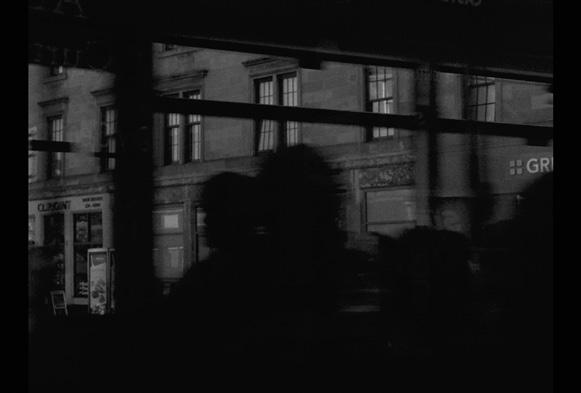





 Introduced by Trinh T. Minhha
Introduced by Trinh T. Minhha

